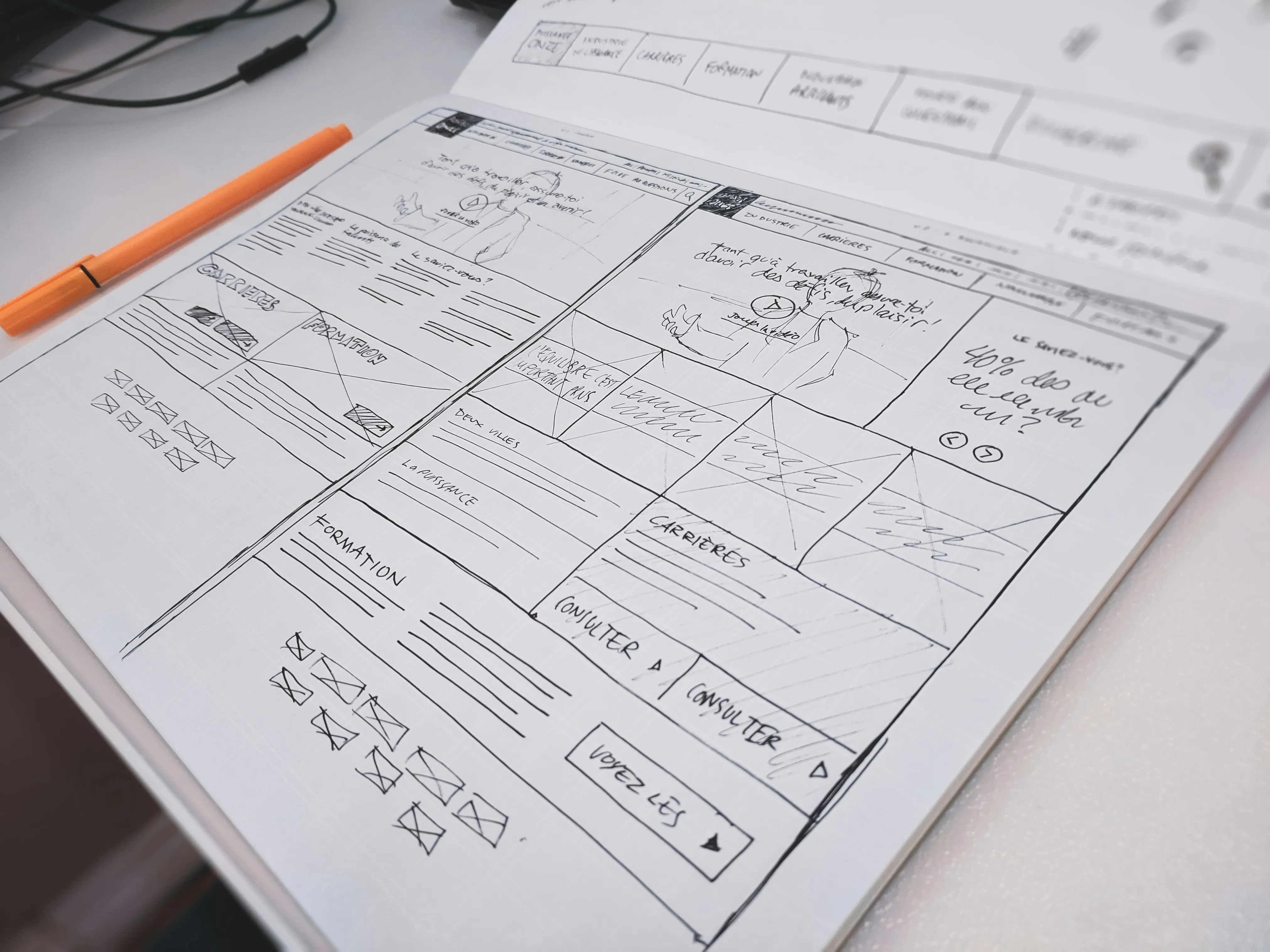Corporate Intranet
Platform
Transforming a legacy internal tool into a scalable, task-oriented intranet for customer service operators
[Preview only – full case available
on desktop 💻]
OVERVIEW
Redesign of a large-scale internal platform for a leading Italian company in the cloud and digital services sector.
The intranet is used daily by internal service operators to handle key business operations across customer care, orders, services, billing, and payments.
Originally built as a legacy system, it had evolved without a clear UX strategy— growing around technical constraints instead of user needs.
We redesigned it to be more intuitive, task-focused, and aligned with real operational needs.
I joined as Senior UX Designer, later taking on the role of Team Lead, guiding the design direction and team coordination.
ABOUT THE PROJECT
Role:
Senior UX Designer → UX Design Lead
Time:
Feb 2023 - Nov 2024
(UX completed, dev in progress)
Team:
4 UX Designers, Product Owners, Business Analysts, Dev Team, Operators platform
Cient:
Name withheld due to confidentiality agreements
Key Challenges
UX DESIGN CHALLENGES
→
Heavy documentation but unclear context: Requirements were unfiltered, jargon-heavy, and hard to interpret
→
Complex processes with minimal digitalization: Many operations relied on workarounds instead of proper digital flows
→
Highly specific business logic: We had to quickly understand complex concepts like refunds, order statuses, and billing rules
→
Designing for operator efficiency, not just usability: Operator habits often clashed with UX best practices
→
Strong resistance to change: Familiar patterns were preferred, even when suboptimal
→
Many voices, mixed priorities: Input came from different stakeholders—each with different priorities and knowledge gaps
PROJECT MANAGEMENt CHALLENGES (as TL)
→
Inheritance of leadership mid-project: Took over from the previous lead, reorganizing the team and clarifying priorities across active streams
→
Project roadmap and Gantt tracking: Managed timelines and deliverables across design and dev phases
→
Internal team coordination: I assigned tasks, supported junior designers, and ensured progress while delivering my own work
→
Task assignment and stream control: I monitored multiple streams and ensured consistency across designs
→
Remote team management: The entire team worked in a fully remote setup, requiring constant alignment and clear documentation
→
Supporting team needs: Handled team needs, blockers, and performance issues as needed
The Process
Structured 4-phase approach from research to delivery, across a complex legacy system.
Research & Analysis → Information Architecture → High-Fidelity Prototyping → Dev Delivery & Handoff
PHASE 1:
Research & Analysis:
→ Requirements
& Documentation
→ Alignment Workshops
& MVP Definition
→ Visual Mapping
for Internal Alignment
Requirements & Documentation
We began by analyzing a large volume of business requirements collected over time by internal operators. The material was highly technical and often unstructured.
To make sense of it, we started organizing the documentation in Excel sheets, providing an initial section-based breakdown of the platform. This helped us clarify functionalities, identify priorities, and create a shared foundation for the next steps.
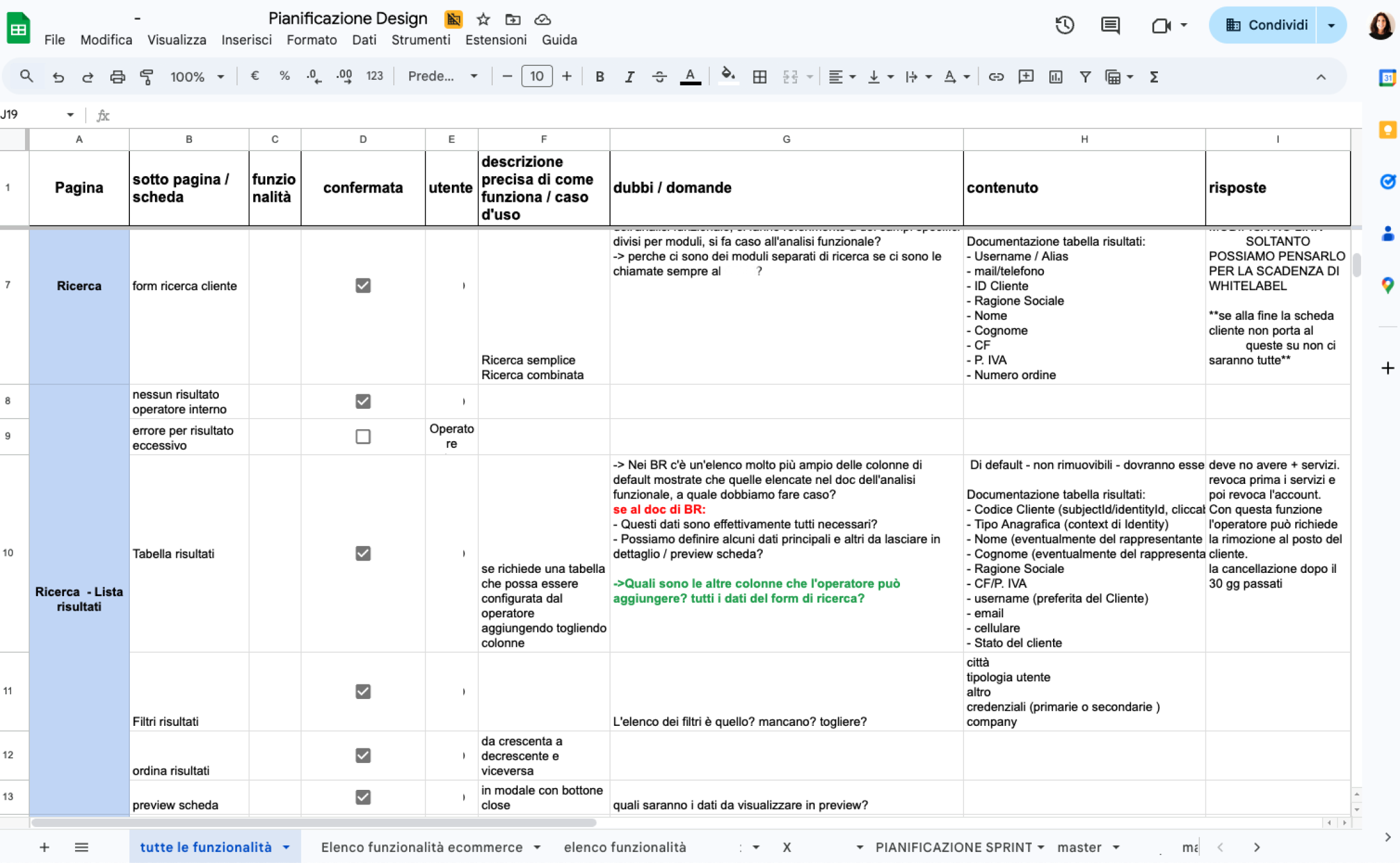
PHASE 1:
Research & Analysis:
→ Requirements
& Documentation
→ Alignment Workshops
& MVP Definition
→ Visual Mapping
for Internal Alignment
Alignment Workshops & MVP Definition
We held dedicated sessions with POs, analysts, and internal operators to review collected requirements, clarify ambiguities, resolve open questions, and validate key functionalities.
The goal was to define the scope of the Minimum Viable Product (MVP) — identifying what was truly essential for go-live, what could be postponed to future iterations, and what was no longer needed.
These confirmations also allowed us to build a clear, shared structure of the platform, laying the groundwork for the next design phases.
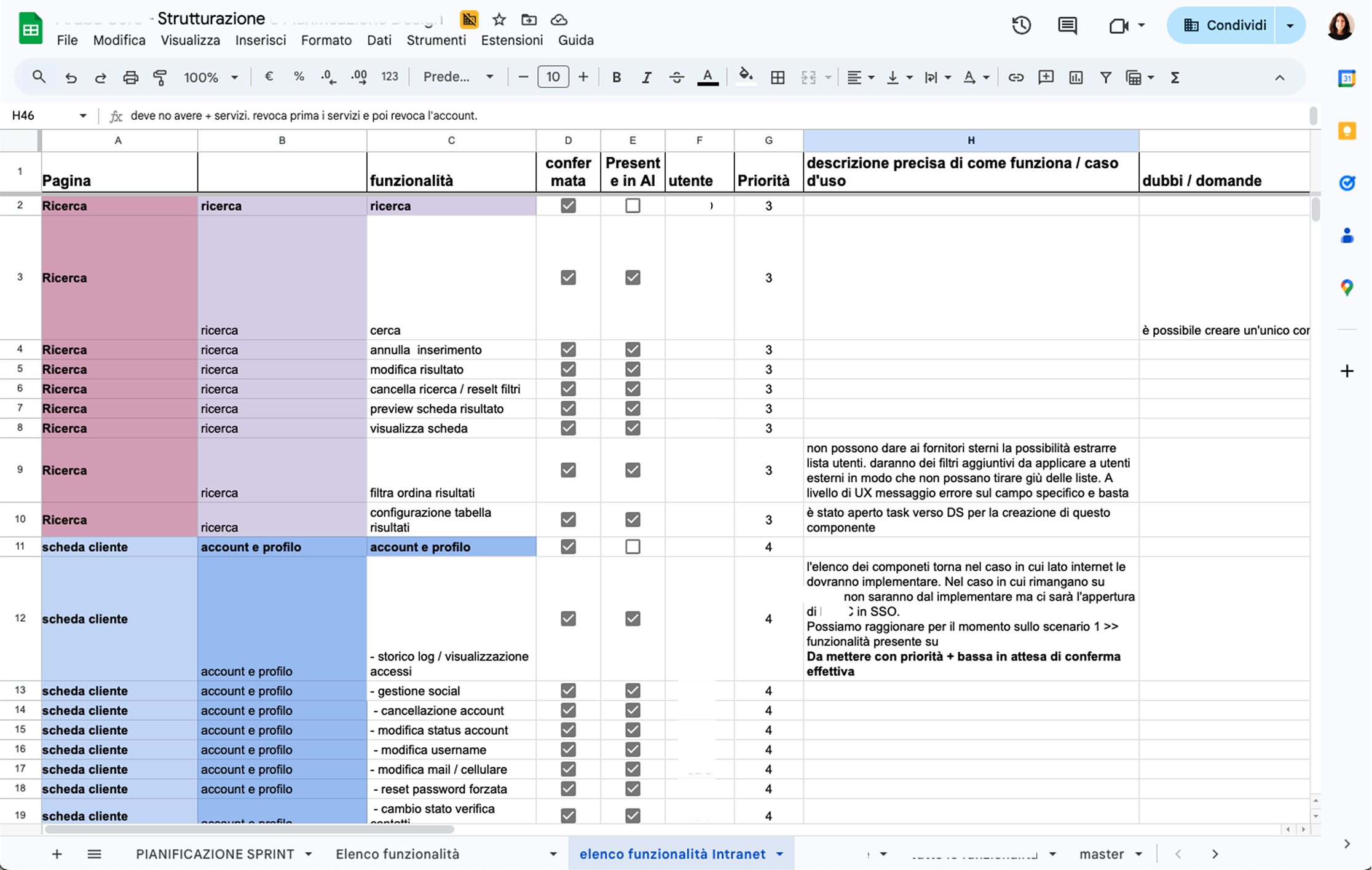
PHASE 1:
Research & Analysis:
→ Requirements
& Documentation
→ Alignment Workshops
& MVP Definition
→ Visual Mapping
for Internal Alignment
Visual Mapping for Internal Alignment
To foster shared understanding, we created visual diagrams and conceptual mappings (such as card sorting) to represent the platform’s sections, content areas, and functional hierarchies.
These materials proved essential in building a clear, organized overview of key blocks and processes, enabling us to structure the initial versions of the Information Architecture more effectively and in alignment with the team.
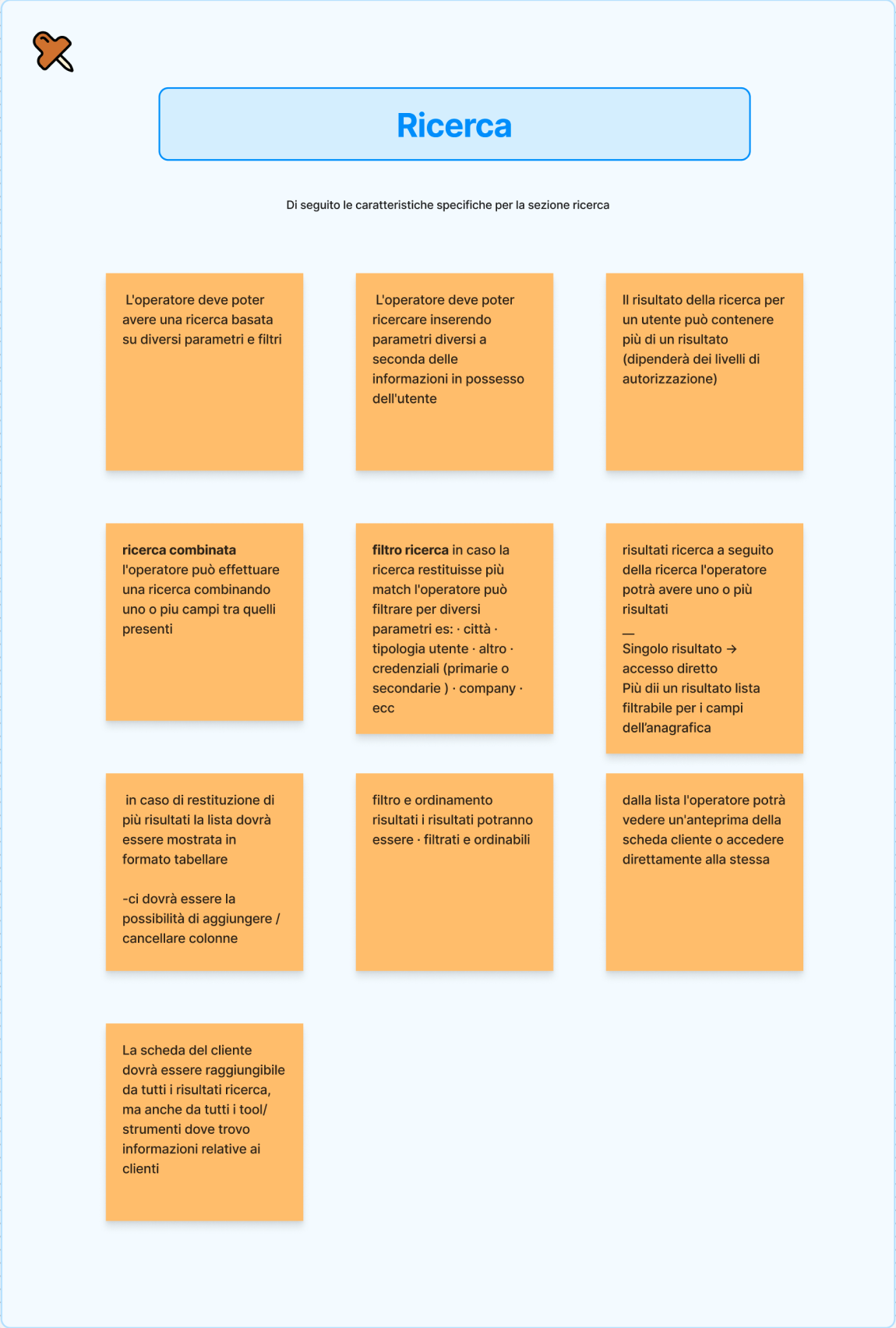
PHASE 1 SUMMARY
→
Mapped 100+ functional requirements from internal documentation
→
Facilitated alignment across multiple stakeholders (POs, analysts, operators)
→
Defined the MVP scope through workshops and interviews
→
Built early visual maps to structure platform sections and functionalities
PHASE 2:
Information Architecture:
→ Information Architecture
by Stream
→ Stakeholder Validation
Information Architecture by Stream
After completing the visual mapping, we had a clear and organized view of the platform’s functional areas. From this structure, we designed two distinct Information Architectures:
→ Intranet – focused on customer management
→ Massive BackOffice – dedicated to large-scale operations (orders, payments, invoices, and services)
For each stream, we defined sections, sub-sections, features, and navigation models, maintaining a careful balance between a task-based structure — aligned with the operators’ daily workflows — and a more business-oriented view, tied to product lines, team responsibilities, rollout phases, and compliance needs.
[Preview limited on mobile – see full case on larger screen]
PHASE 2: Information Architecture:
→ Information Architecture
by Stream
→ Stakeholder Validation
Stakeholder Validation
Presentation and validation of the Information Architectures with various groups: PO, operators, analysts, and billing team. Several iterations were required due to frictions between existing operational flows and the proposed simplifications.
📆
Planning & Release Roadmap:
Once the Information Architectures were validated by key stakeholders (PO, operators, analysts, and the billing team), we moved on to the next phase with a detailed roadmap.
The platform sections were broken down into project milestones, each assigned a specific level of effort, priority, and dependencies.
This planning phase was led directly by me in the role of Team Lead, and resulted in the definition of the Gantt chart, workstreams, and delivery schedule for the entire design phase.
(Project coordination will be further detailed in the dedicated project management section).
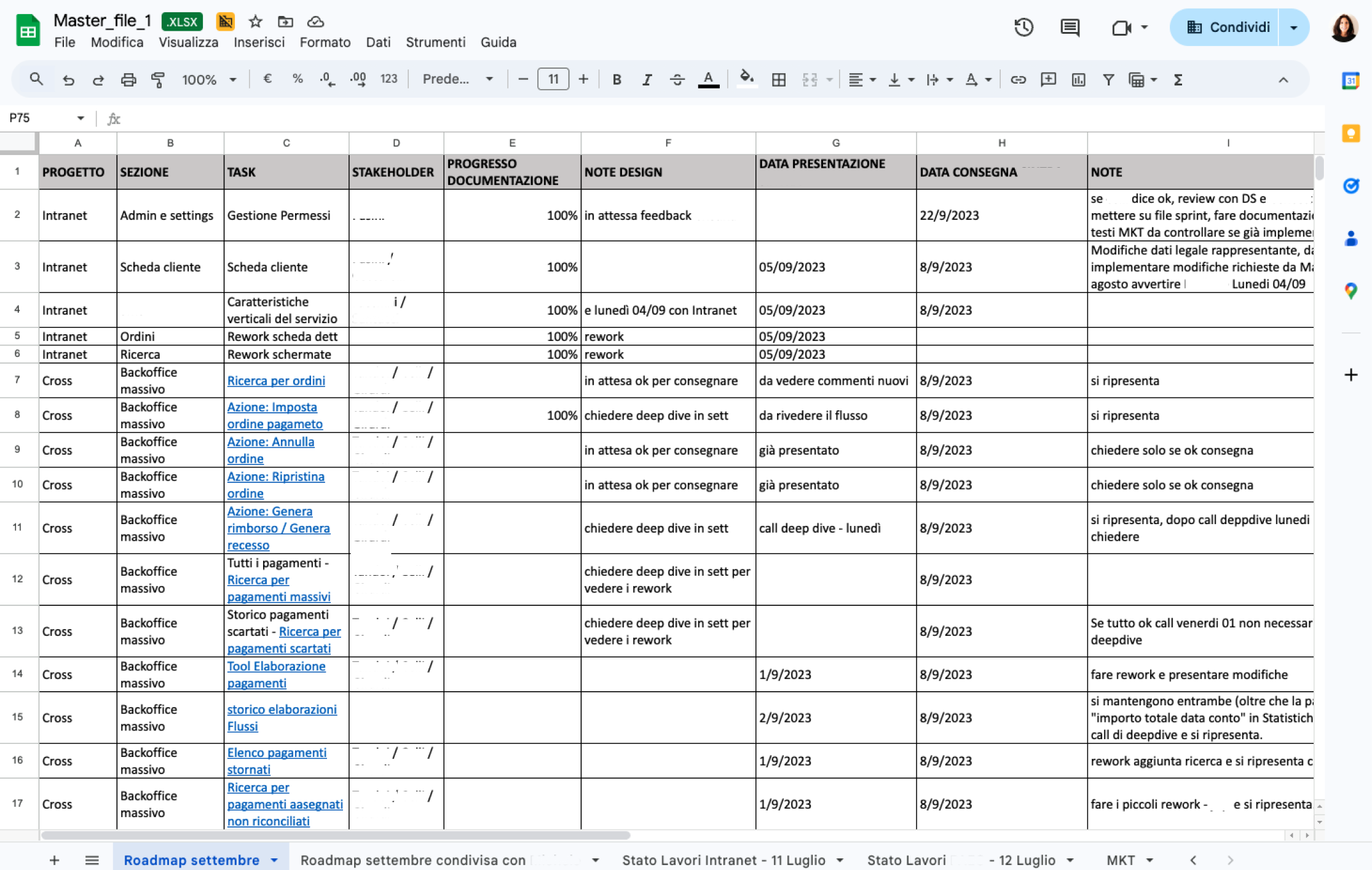
PHASE 2 SUMMARY
→
Designed two distinct structures: Intranet (Customer Management) and Massive BackOffice (Bulk Operations)
→
Defined a scalable navigation model tailored to user roles and usage frequency
→
Prioritized content and features based on task criticality and business priorities
→
Validated the Information Architecture with cross-functional stakeholders
→
Structured the project roadmap and Gantt chart to guide design milestones
PHASE 3:
High-Fidelity Prototyping:
→ Overview
→ Navigation Logic
→ Table Behavior
→ Customer Sheet
→ Massive BackOffice
→ Team Alignment
Overview: Method, Constraints & Approach
All user flows were designed directly in high-fidelity using Figma, leveraging the client’s existing design system. Through continuous collaboration with stakeholders, analysts, and service operators, we adapted this B2C-oriented design system to the operational needs of a complex internal back-end tool.
We addressed legacy constraints, redefined interaction rules, and validated complex flows in areas such as billing, payments, and financial reporting—domains initially unfamiliar to the team.
🎯
Goal:
Design an operational, task-based platform by translating complex logic into clear, dense —but navigable— flows.

PHASE 3:
High-Fidelity Prototyping:
→ Overview
→ Navigation Logic
→ Table Behavior
→ Customer Sheet
→ Massive BackOffice
→ Team Alignment
Entry Point & Navigation Logic
We started by designing the navigation system: from the main menu to the landing page.
The first challenge was deciding whether the entry point should be a Dashboard or a Customer Search.
Operators clarified that every phone call starts with identifying a customer → therefore, the true homepage needed to be the search module.
🎯
Goal:
Ensure immediate access to daily operations.
💬
Insight
The IA was solid, but visual support was needed to make it understandable to non-UX stakeholders.
[Preview limited on mobile – see full case on larger screen]
PHASE 3:
High-Fidelity Prototyping:
→ Overview
→ Navigation Logic
→ Table Behavior
→ Customer Sheet
→ Massive BackOffice
→ Team Alignment
Table Behavior & Action Logic
Tables were a major usability issue: overloaded, horizontally scrollable, and with actions hidden in the far-right column—per B2C DS rules.
From user testing, it was clear that actions needed to be immediate and visible.
We restructured the tables so that:
→ The first column became the main access point
→ Actionable columns became fully clickable, speeding up task execution
🎯
Goal:
Adapt the design system to real, daily operational needs.
💬
Insight
Fewer clicks → faster tasks → large-scale efficiency.
PHASE 3:
High-Fidelity Prototyping:
→ Overview
→ Navigation Logic
→ Table Behavior
→ Customer Sheet
→ Massive BackOffice
→ Team Alignment
Customer Sheet & Order Logic
The customer profile included highly complex flows: orders, active services, statuses, and conditional actions.The biggest blocker was the order status, initially described as simple, but actually composed of three interdependent layers, each affecting system behavior.
To resolve this, we co-created a Status → Actions matrix with stakeholders across Finance, POs, Service, and Billing to ensure alignment.
🎯
Goal:
Clarify what users can (or cannot) do depending on order status.
💬
Insight
Without a shared understanding of order status, UX flows were fragile and unreliable.
[Preview limited on mobile – see full case on larger screen]
PHASE 3:
High-Fidelity Prototyping:
→ Overview
→ Navigation Logic
→ Table Behavior
→ Customer Sheet
→ Massive BackOffice
→ Team Alignment
Massive BackOffice & Automation
This stream had a dedicated IA, roadmap, and stakeholder group.We tackled little-known workflows (e.g. reporting, failed payments) that involved highly technical logic.
Our main challenge was to understand how operators really work.Example: managing failed payments required introducing operational statuses like “in progress”, “claimed”, and “released”
to avoid overlap between colleagues.
🎯
Goal:
Design flows with high automation and clear operational visibility.
💬
Insight
Critical insights came not from documents, but from operators’ real-life stories.
[Preview limited on mobile – see full case on larger screen]
PHASE 3:
High-Fidelity Prototyping:
→ Overview
→ Navigation Logic
→ Table Behavior
→ Customer Sheet
→ Massive BackOffice
→ Team Alignment
Continuous Validation
& Team Alignment
Each section went through multi-step validation:
→ With Analysts and POs for business logic
→ With Operators for real-world usability
→ With the Marketing team for naming and microcopy consistency
We also documented every design decision to reduce ambiguity and create a single source of truth.
🎯
Goal:
Avoid infinite feedback loops and ensure UX coherence.
💬
Insight
Design became a tool for internal alignment, not just a visual output.
Representative cases, broader impact:
This project went through many phases and iterations.In this case study, I’ve focused on the most representative examples—those that pushed the design forward and show the value of our collaboration across teams.
PHASE 4:
Dev Delivery & Handoff:
→ Progressive Design Handoff
by Stream
→ Support During Development
& QA
Progressive Design Handoff
by Stream
Each section was delivered progressively, following the priority order defined in the roadmap. Every delivery included a structured handoff and dedicated alignment sessions with the development teams.
PHASE 4:
Dev Delivery & Handoff:
→ Progressive Design Handoff
by Stream
→ Support During Development
& QA
Support During Development
& QA
Throughout the implementation phase, we supported the dev teams by addressing functional questions, providing additional documentation when needed, and assisting QA in identifying mismatches between prototypes and test environments.
[The project is currently in an advanced development stage, with several sections already released in the test environment and others in progressive rollout].
Team Leadership & Project Coordination
From designer to strategic lead in a fully-remote, multi-stream environment.
UX LEADERSHIP
& TEAM OPERATIONS
Role evolution
→
Started as Senior UX Designer
→
Took over as UX Team Lead mid-project
→
Managed 3 UX Designers and owned delivery across UX streams
Team management
→
Planned and assigned design tasks across workstreams
→
Recruited and onboarded a junior designer
→
Supported team members in daily work and professional growth
Cross-team coordination
→
Aligned with POs, analysts, developers, and business stakeholders
→
Maintained UX Gantt and synced with product stream roadmaps
→
Bridged gaps between UX, tech, and business
Processes & collaboration
→
Led remote collaboration via Figma, FigJam, Jira, Confluence
→
Conducted regular design reviews and design–dev QA
→
Maintained documentation and source-of-truth boards
STRATEGIC IMPACT
& PRODUCT THINKING
Product thinking & ownership
→
Contributed to MVP scoping based on user priorities and tech constraints
→
Balanced task-based flows with long-term product strategy
→
Worked closely with POs to shape feature sets and release plans
Results & impact (even partial)
→
Accelerated onboarding through streamlined UX flows
→
Reduced operator time via clear, task-oriented navigation
→
Designed scalable UX patterns now reused across multiple business lines
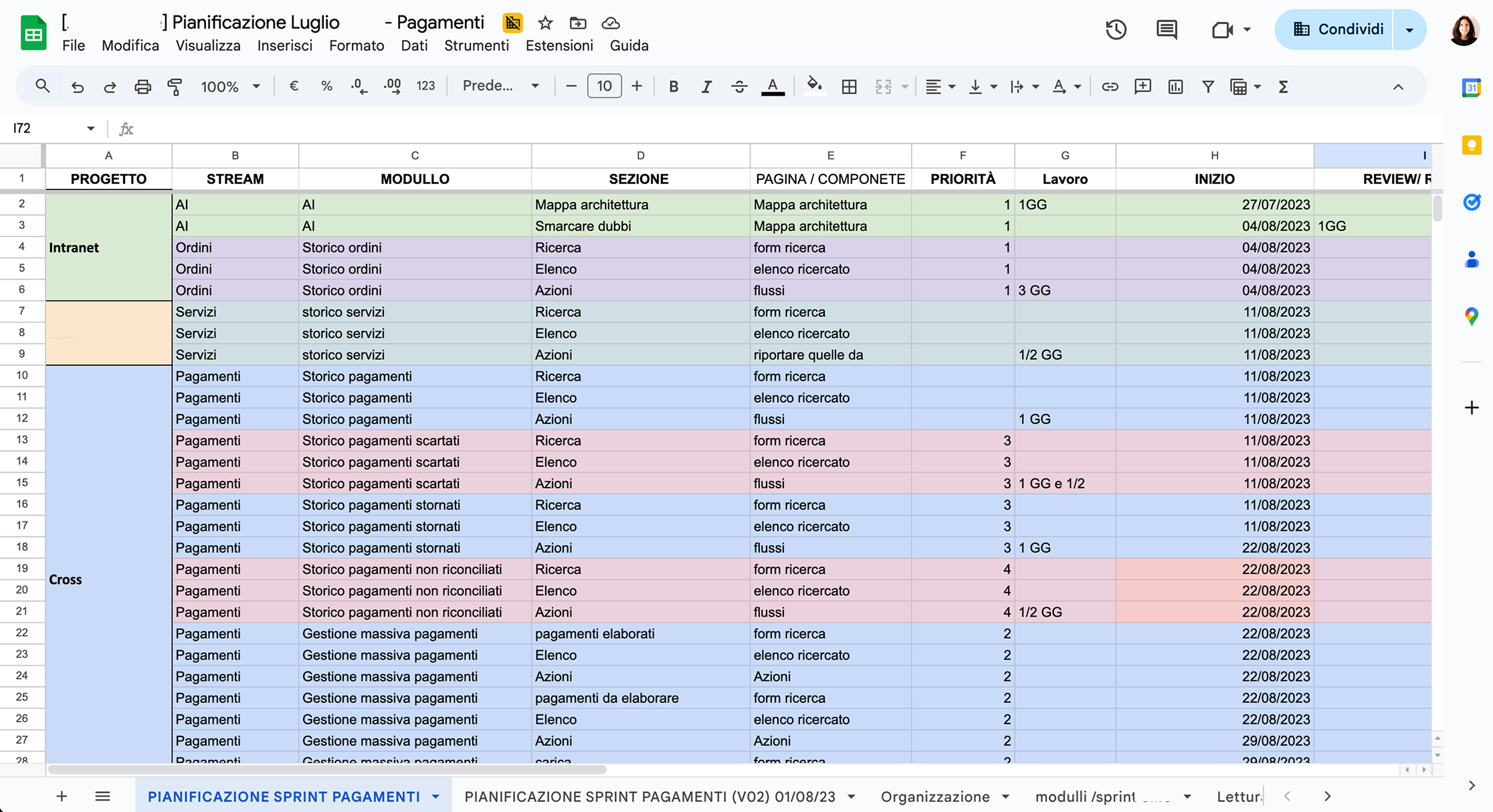
Learnings & Takeaways
In a project of this complexity – with strong technical constraints, a difficult-to-unravel legacy, and misaligned stakeholders – I learned that clarity, structure, and empathy are just as essential as Figma.
I had to adapt, lead, resolve conflicts, simplify complexity, and at the same time preserve design quality and team rhythm.
This was the first project where I truly grew from UX Designer to Team Lead, learning to balance ownership, support, and product vision.
As UX Designer
→
Simplified complex rules: Turned a legacy platform into clearer flows through workshops and co-design
→
Redesigned patterns: Adapted B2C design logic to fit real B2B operations
→
Bridged gaps: Led discovery sessions with analysts to clarify missing specs
→
Gained alignment: Used visual storytelling to persuade stakeholders new to UX
As UX Team Lead
→
Took over mid-project: Rebuilt the UX backlog, roadmap, and priorities
→
Supported the team: Balanced delivery pressure with mentoring and growth
→
Orchestrated alignment: Synced with Product Owners, devs, and analysts
→
Scoped the MVP: Defined incremental logic and user stories for rollout
→
Turned data into action: Tested flows and converted findings into UX fixes
MORE PROJECTS
Whitelable E-commerce Ecosystem
End-to-end UX design of a custom enterprise platform — from business needs to tested product.
View Case Study
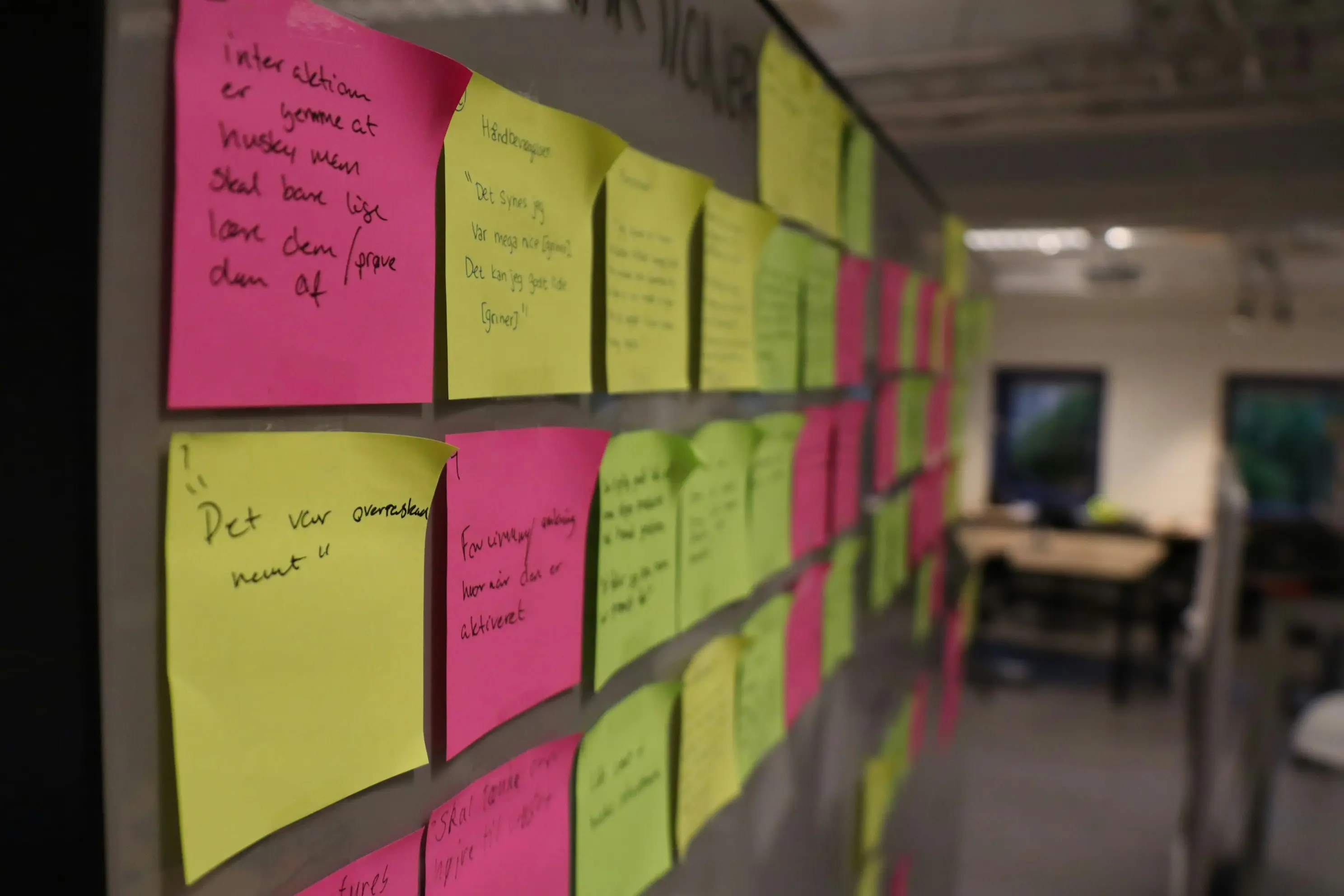
Push Notifications for Mobile Banking app
Enhancing UX with a clear and scalable communication system
View Case Study
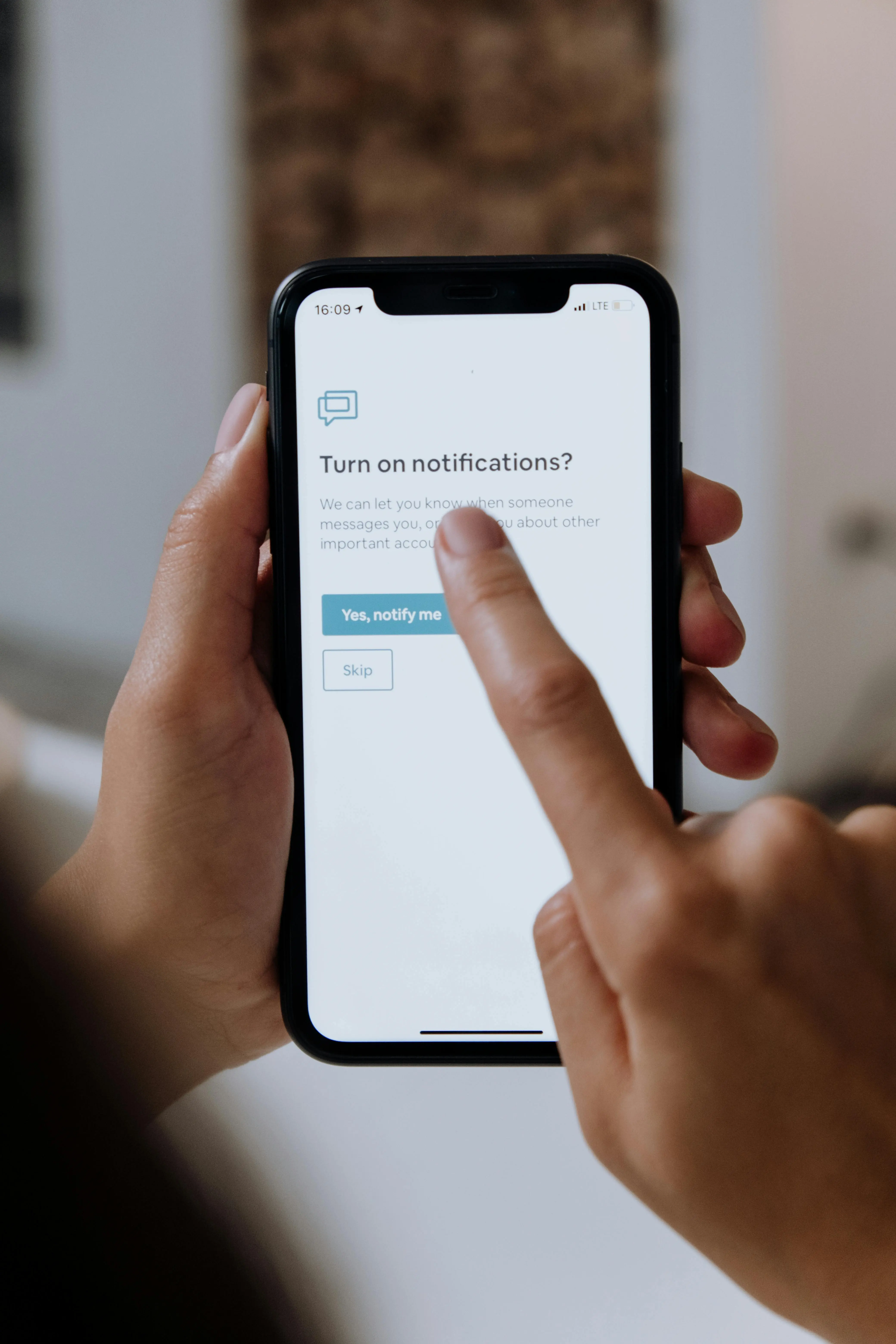
Enterprise Solutions / B2B Platform / Complex Workflows
Corporate Intranet
Platform
Transforming a legacy internal tool into a scalable, task-oriented intranet for customer service operators
OVERVIEW
Redesign of a large-scale internal platform for a leading Italian company in the cloud and digital services sector.
The intranet is used daily by internal service operators to handle key business operations across customer care, orders, services, billing, and payments.
Originally built as a legacy system, it had evolved without a clear UX strategy— growing around technical constraints instead of user needs.
We redesigned it to be more intuitive, task-focused, and aligned with real operational needs.
I joined as Senior UX Designer, later taking on the role of Team Lead, guiding the design direction and team coordination.
ABOUT THE PROJECT
Role:
Senior UX Designer → UX Design Lead
Time:
Feb 2023 - Nov 2024 (UX completed, dev in progress)
Team:
4 UX Designers, Product Owners, Business Analysts, Dev Team, Operators platform
Cient:
Name withheld due to confidentiality agreements
Key Challenges
UX DESIGN CHALLENGES
→
Heavy documentation but unclear context: Requirements were unfiltered, jargon-heavy, and hard to interpret
→
Complex processes with minimal digitalization: Many operations relied on workarounds instead of proper digital flows
→
Highly specific business logic: We had to quickly understand complex concepts like refunds, order statuses, and billing rules
→
Designing for operator efficiency, not just usability: Operator habits often clashed with UX best practices
→
Strong resistance to change: Familiar patterns were preferred, even when suboptimal
→
Many voices, mixed priorities: Input came from different stakeholders—each with different priorities and knowledge gaps
PROJECT MANAGEMENt CHALLENGES (as TL)
→
Inheritance of leadership mid-project: Took over from the previous lead, reorganizing the team and clarifying priorities across active streams
→
Project roadmap and Gantt tracking: Managed timelines and deliverables across design and dev phases
→
Internal team coordination: I assigned tasks, supported junior designers, and ensured progress while delivering my own work
→
Task assignment and stream control: I monitored multiple streams and ensured consistency across designs
→
Remote team management: The entire team worked in a fully remote setup, requiring constant alignment and clear documentation
→
Supporting team needs: Handled team needs, blockers, and performance issues as needed
The Process
Structured 4-phase approach from research to delivery, across a complex legacy system.
Research & Analysis → Information Architecture → High-Fidelity Prototyping → Dev Delivery & Handoff
PHASE 1: Research & Analysis:
→ Requirements & Documentation
→ Alignment Workshops & MVP Definition
→ Visual Mapping for Internal Alignment
Requirements & Documentation
We began by analyzing a large volume of business requirements collected over time by internal operators. The material was highly technical and often unstructured.
To make sense of it, we started organizing the documentation in Excel sheets, providing an initial section-based breakdown of the platform. This helped us clarify functionalities, identify priorities, and create a shared foundation for the next steps.

PHASE 1: Research & Analysis:
→ Requirements & Documentation
→ Alignment Workshops & MVP Definition
→ Visual Mapping for Internal Alignment
Alignment Workshops & MVP Definition
We held dedicated sessions with POs, analysts, and internal operators to review collected requirements, clarify ambiguities, resolve open questions, and validate key functionalities.
The goal was to define the scope of the Minimum Viable Product (MVP) — identifying what was truly essential for go-live, what could be postponed to future iterations, and what was no longer needed.
These confirmations also allowed us to build a clear, shared structure of the platform, laying the groundwork for the next design phases.

PHASE 1: Research & Analysis:
→ Requirements & Documentation
→ Alignment Workshops & MVP Definition
→ Visual Mapping for Internal Alignment
Visual Mapping for Internal Alignment
To foster shared understanding, we created visual diagrams and conceptual mappings (such as card sorting) to represent the platform’s sections, content areas, and functional hierarchies.
These materials proved essential in building a clear, organized overview of key blocks and processes, enabling us to structure the initial versions of the Information Architecture more effectively and in alignment with the team.
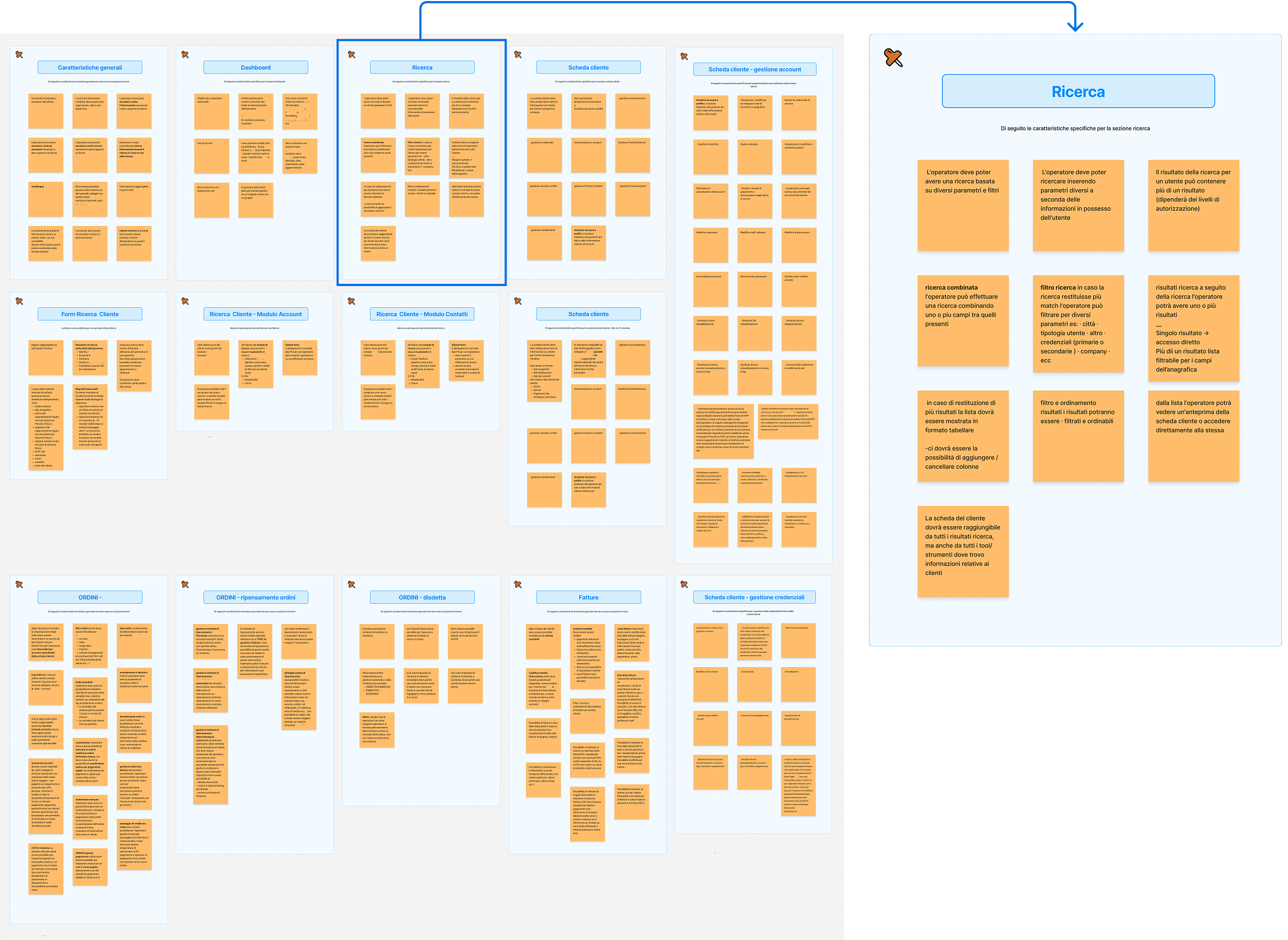
PHASE 1 SUMMARY
→
Mapped 100+ functional requirements from internal documentation
→
Facilitated alignment across multiple stakeholders (POs, analysts, operators)
→
Defined the MVP scope through workshops and interviews
→
Built early visual maps to structure platform sections and functionalities
PHASE 2: Information Architecture:
→ Information Architecture by Stream
→ Stakeholder Validation
Information Architecture by Stream
After completing the visual mapping, we had a clear and organized view of the platform’s functional areas. From this structure, we designed two distinct Information Architectures:
→ Intranet – focused on customer management
→ Massive BackOffice – dedicated to large-scale operations (orders, payments, invoices, and services)
For each stream, we defined sections, sub-sections, features, and navigation models, maintaining a careful balance between a task-based structure — aligned with the operators’ daily workflows — and a more business-oriented view, tied to product lines, team responsibilities, rollout phases, and compliance needs.
Admin settings
Dashboard
Customer Search
BackOffice (Massive)
INTRANET
Customer Sheet
Order Management,
Billing & Payments
Service Configuration
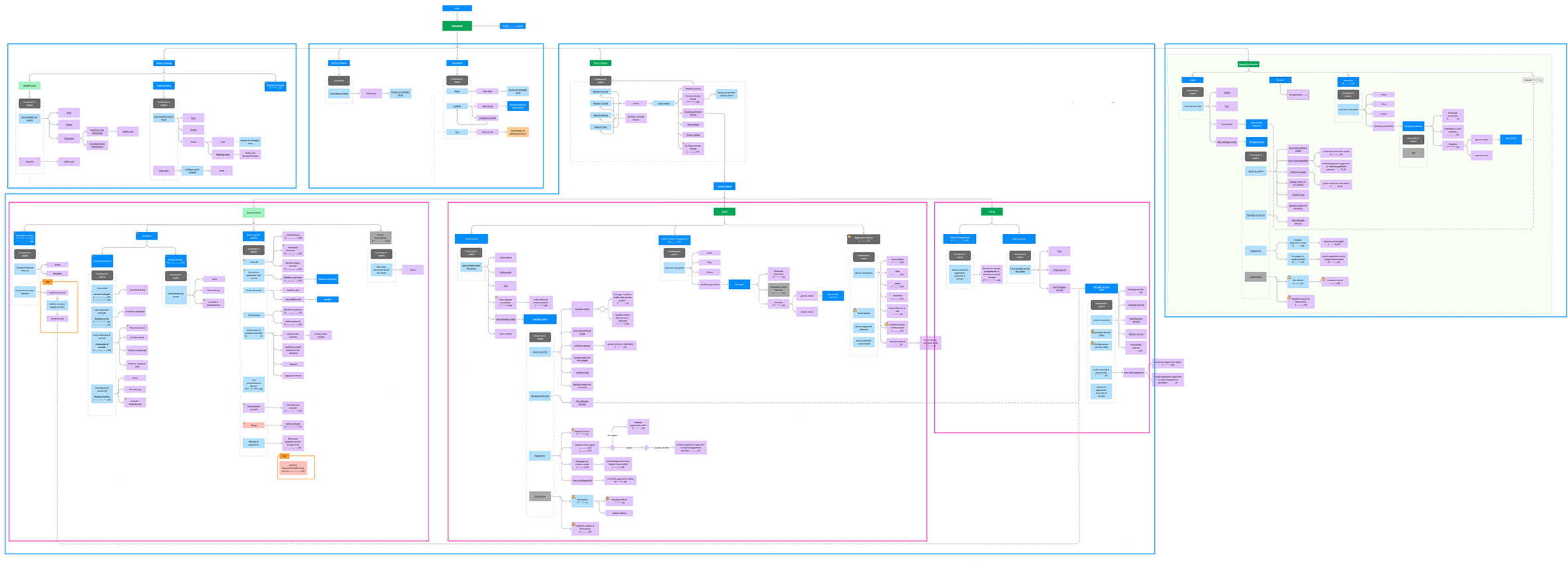
Order Management
Billing & Payments
Service Configuration
Shopping Cart
Massive BackOffice
Failed Payments [operational statuses]

PHASE 2: Information Architecture:
→ Information Architecture by Stream
→ Stakeholder Validation
Stakeholder Validation
Presentation and validation of the Information Architectures with various groups: PO, operators, analysts, and billing team. Several iterations were required due to frictions between existing operational flows and the proposed simplifications.
📆
Planning & Release Roadmap:
Once the Information Architectures were validated by key stakeholders (PO, operators, analysts, and the billing team), we moved on to the next phase with a detailed roadmap.
The platform sections were broken down into project milestones, each assigned a specific level of effort, priority, and dependencies.
This planning phase was led directly by me in the role of Team Lead, and resulted in the definition of the Gantt chart, workstreams, and delivery schedule for the entire design phase.
(Project coordination will be further detailed in the dedicated project management section).

PHASE 2 SUMMARY
→
Designed two distinct structures: Intranet (Customer Management) and Massive BackOffice (Bulk Operations)
→
Defined a scalable navigation model tailored to user roles and usage frequency
→
Prioritized content and features based on task criticality and business priorities
→
Validated the Information Architecture with cross-functional stakeholders
→
Structured the project roadmap and Gantt chart to guide design milestones
PHASE 3: High-Fidelity Prototyping:
→ Overview
→ Navigation Logic
→ Table Behavior
→ Customer Sheet
→ Massive BackOffice
→ Team Alignment
Overview: Method, Constraints & Approach
All user flows were designed directly in high-fidelity using Figma, leveraging the client’s existing design system. Through continuous collaboration with stakeholders, analysts, and service operators, we adapted this B2C-oriented design system to the operational needs of a complex internal back-end tool.
We addressed legacy constraints, redefined interaction rules, and validated complex flows in areas such as billing, payments, and financial reporting—domains initially unfamiliar to the team.
🎯
Goal:
Design an operational, task-based platform by translating complex logic into clear, dense —but navigable— flows.

PHASE 3: High-Fidelity Prototyping:
→ Overview
→ Navigation Logic
→ Table Behavior
→ Customer Sheet
→ Massive BackOffice
→ Team Alignment
Entry Point & Navigation Logic
We started by designing the navigation system: from the main menu to the landing page.
The first challenge was deciding whether the entry point should be a Dashboard or a Customer Search.
Operators clarified that every phone call starts with identifying a customer → therefore, the true homepage needed to be the search module.
🎯
Goal:
Ensure immediate access to daily operations.
💬
Insight
The IA was solid, but visual support was needed to make it understandable to non-UX stakeholders.
CUSTOMER SHEET
All relevant customer data in one place—orders, services, actions.
This screen is the operational hub where tasks are performed.
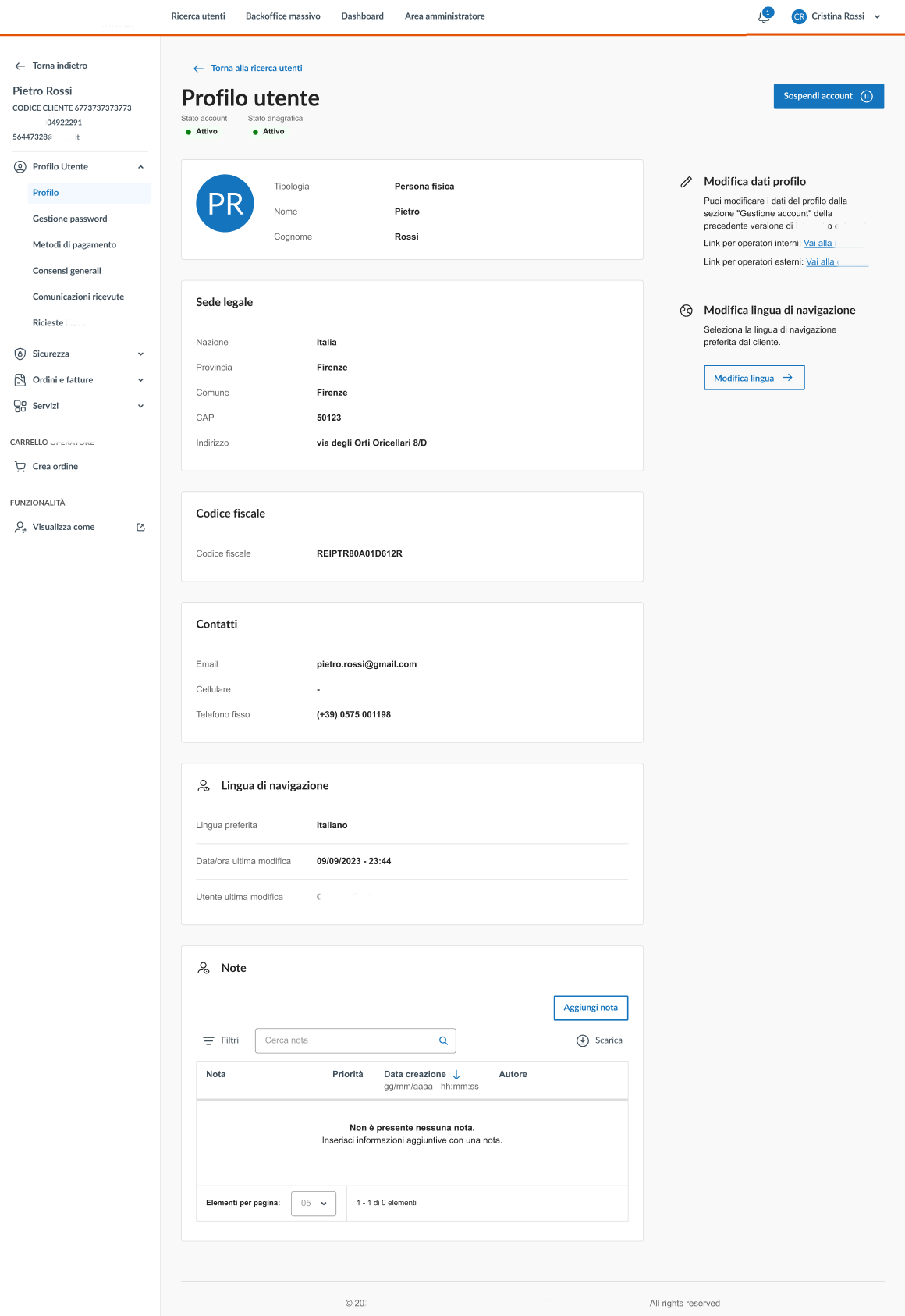
HOMEPAGE AS-IS: Dashboard
The original homepage of the tool, displaying service updates and widgets.While informative, it didn’t support operators' actual workflows, as every action starts with a customer search.
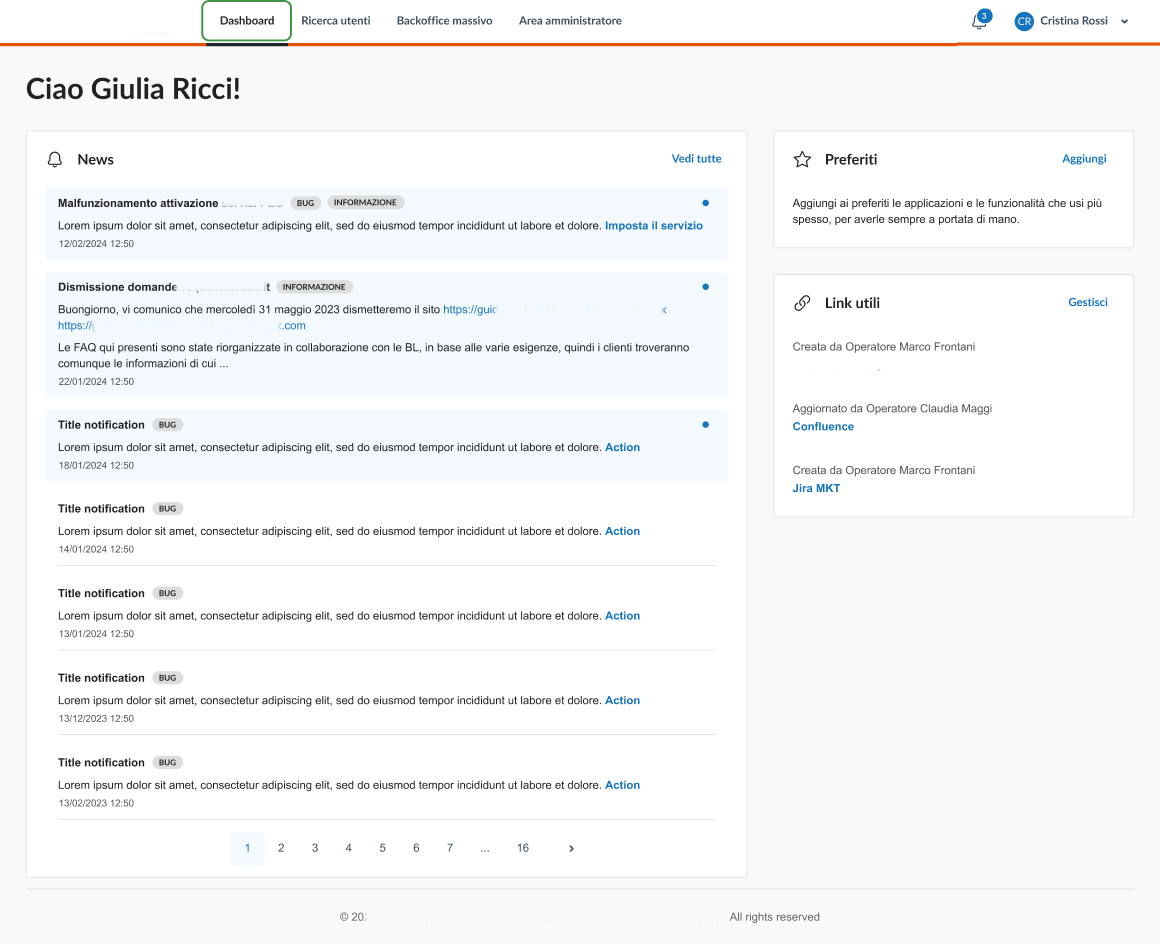
HOMEPAGE TO-BE: CUSTOMER SEARCH
After submitting a search, the input panel collapses to make room for results.
Operators can refine or restart their search with clear, dedicated buttons.
The redesigned entry point.Operators land here and immediately input customer data to begin a task.Simple, focused, and operational.
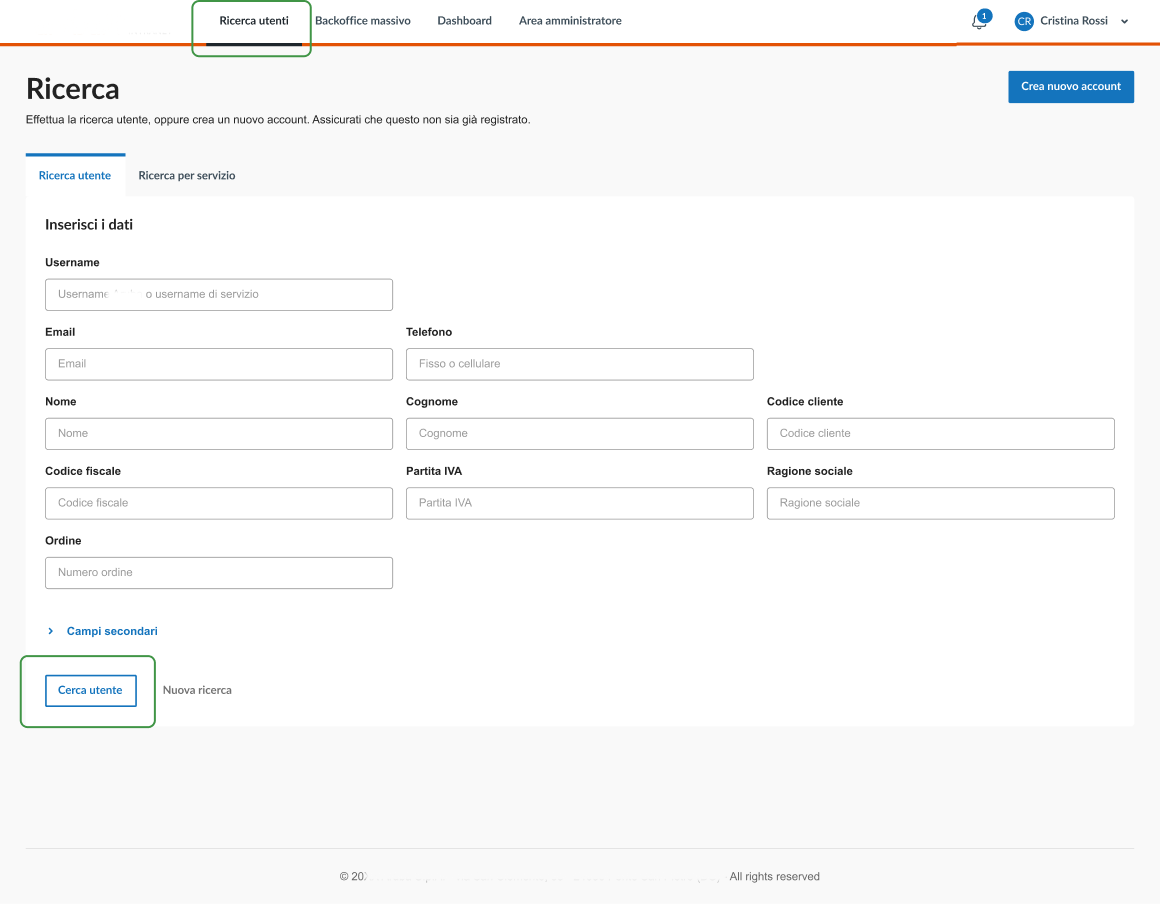
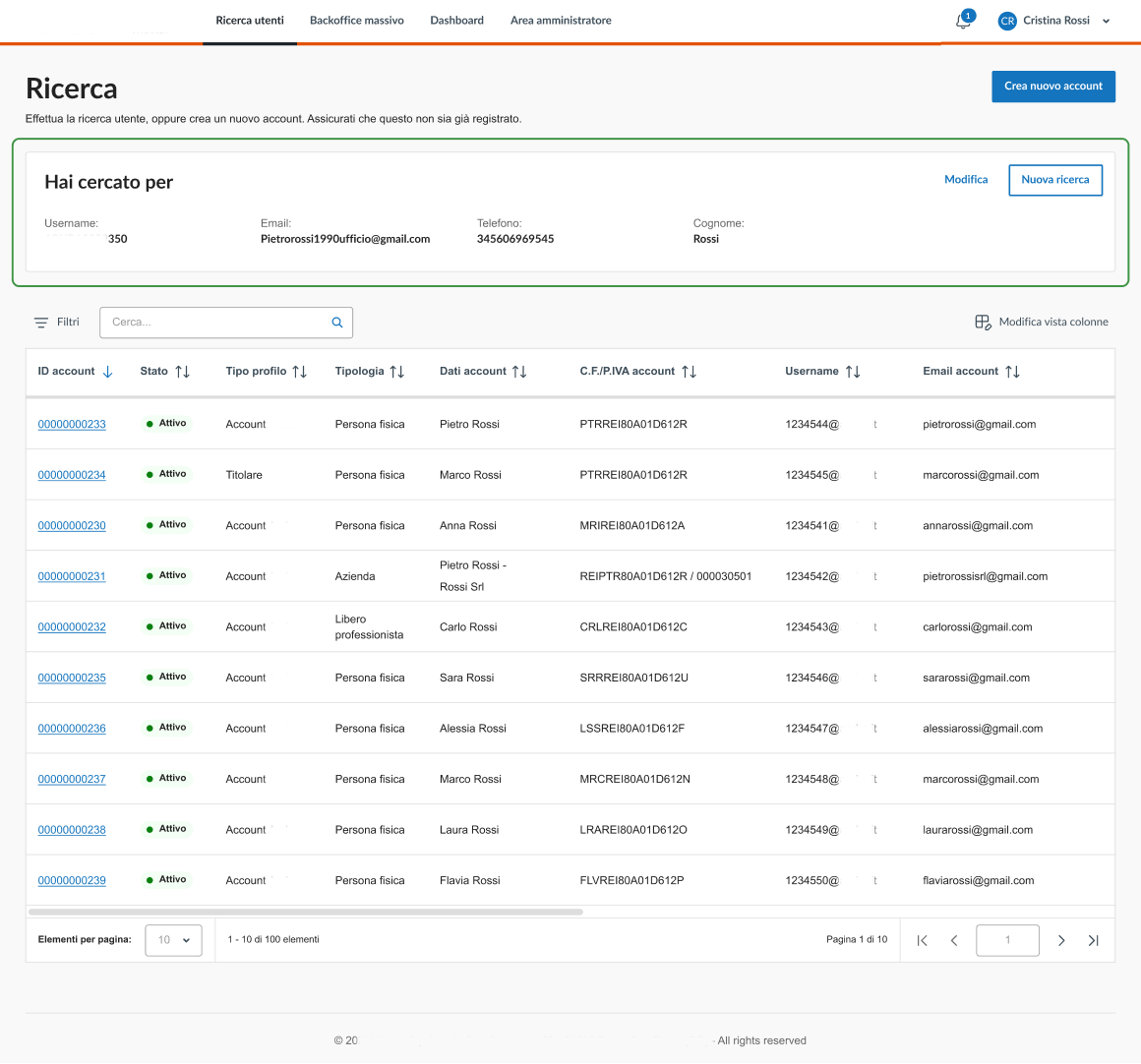
PHASE 3: High-Fidelity Prototyping:
→ Overview
→ Navigation Logic
→ Table Behavior
→ Customer Sheet
→ Massive BackOffice
→ Team Alignment
Table Behavior & Action Logic
Tables were a major usability issue: overloaded, horizontally scrollable, and with actions hidden in the far-right column—per B2C DS rules.
From user testing, it was clear that actions needed to be immediate and visible.
We restructured the tables so that:
→ The first column became the main access point
→ Actionable columns became fully clickable, speeding up task execution
🎯
Goal:
Adapt the design system to real, daily operational needs.
💬
Insight
Fewer clicks → faster tasks → large-scale efficiency.
All possible actions were grouped in the last column.
Operators first had to identify the right row, then select an action— often requiring extra steps even for frequent tasks like opening order or payment details.
Actions in the right column (AS-IS)
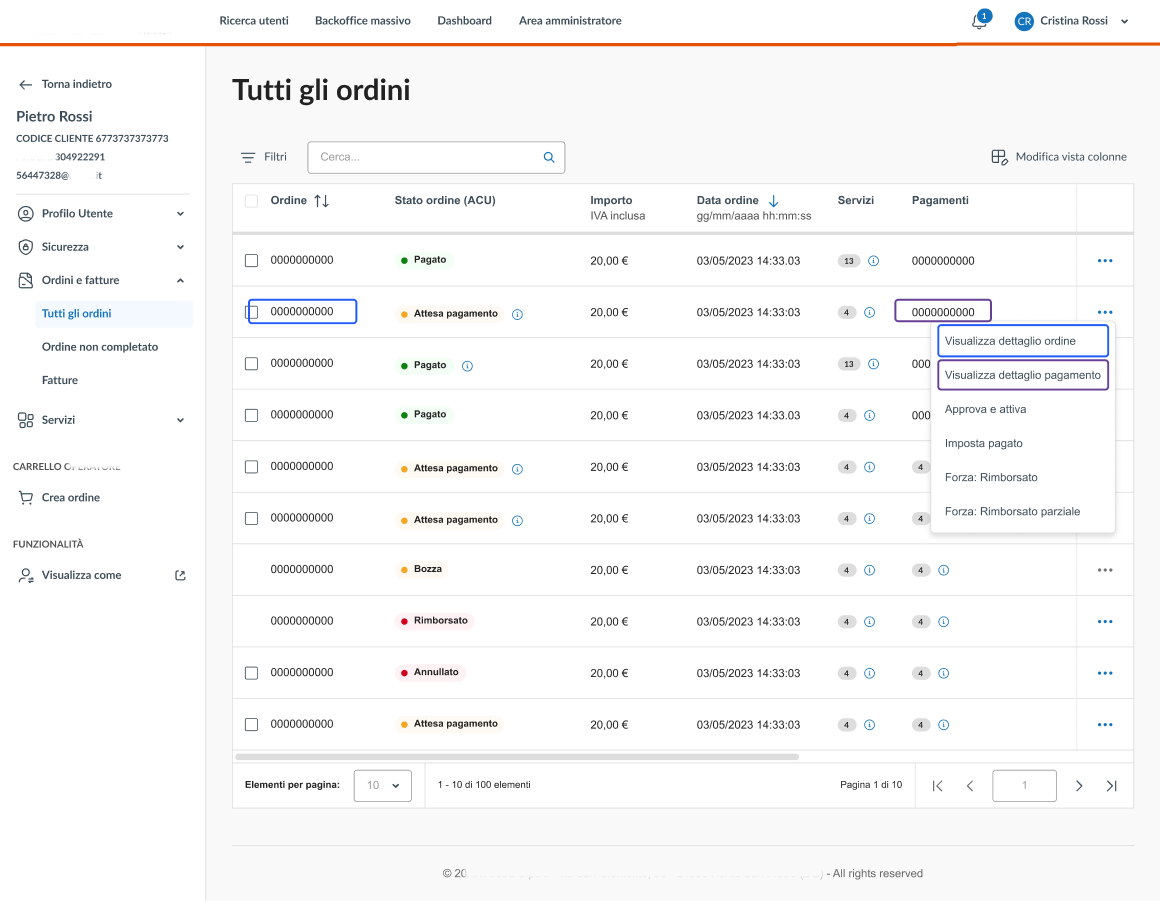
The Order and Payment columns became fully clickable, allowing direct access to related details. Action buttons were reduced to those strictly needed for operational tasks.
Clickable columns for faster access (TO-BE)
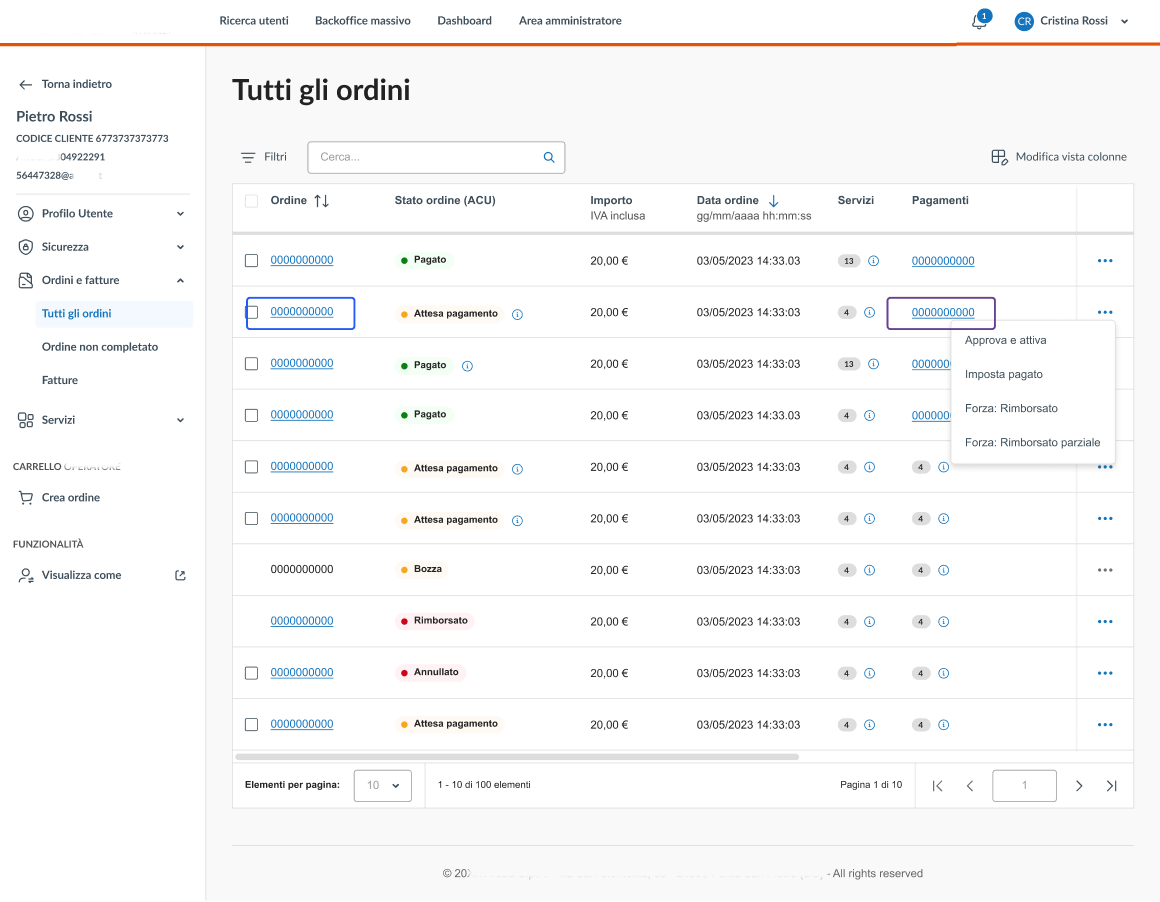
PHASE 3: High-Fidelity Prototyping:
→ Overview
→ Navigation Logic
→ Table Behavior
→ Customer Sheet
→ Massive BackOffice
→ Team Alignment
Customer Sheet & Order Logic
The customer profile included highly complex flows: orders, active services, statuses, and conditional actions.The biggest blocker was the order status, initially described as simple, but actually composed of three interdependent layers, each affecting system behavior.
To resolve this, we co-created a Status → Actions matrix with stakeholders across Finance, POs, Service, and Billing to ensure alignment.
🎯
Goal:
Clarify what users can (or cannot) do depending on order status.
💬
Insight
Without a shared understanding of order status, UX flows were fragile and unreliable.
Status → Actions Matrix
Approvato
AZIONI
NUOVO RILASCIO
Approvato
Approved
Approved
Pagato
Pagato
Attivo
Non attivo
Paid
Paid
Fulfilled
Unfulfilled
PAGATO
PAGATO
PAGATO
PAGATO
STATO ODA
eCom
STATO INTRANET
STATO ACU
STATO
PROVISIONING
STATO
PAGAMENTO
Nuovo
Approvato
Approvato
Approvato
Approvato
Approvato
Nuovo
New
Pagato
Non attivo
Approvato
Paid
Approved
Approved
Nuovo
Unfulfilled
Approved
Autorizzato
Approved
Approved
PAGATO
Autorizzato
In corso
New
Non attivo
PAGATO
Parzialmente
rimborsato
Parzialmente
rimborsato
Autorizzato
Authorized
Authorized
In corso
Attivo
Attivo
In Progress
Unfulfilled
Partially refunded
Partially refunded
Parzialmente
rimborsato
Authorized
Approved
Fulfilled
In Progress
PAGATO
Non attivo
PAGATO
PAGATO
Fulfilled
PAGATO
Partially refunded
PAGATO
New
Unfulfilled
PAGATO
Pagato
PAGATO
PAGATO
PAGATO
Autorizzato
In corso
Non attivo
Paid
Authorized
In Progress
Unfulfilled
PAGATO
PAGATO
PAGATO
PAGATO
PAGATO
Parzialmente rimborsato
PAGATO
Parzialmente rimborsato
PAGATO
Parzialmente rimborsato
Genera rimborso
Forza: RImborsato
Forza: Rimborsato parziale
Genera rimborso
Forza: RImborsato
Forza: Rimborsato parziale
Genera Rimborso
Forza: Rimborsato
Forza: Rimborsato parziale
Forza: Rimborsato
Forza: Rimborsato parziale
Genera Rimborso
Forza: Rimborsato
Forza: Rimborsato parziale
Imposta Pagato
Forza: Rimborsato
Forza: Rimborsato parziale
Imposta Pagato
Forza: Rimborsato
Forza: Rimborsato parziale
Forza: Rimborsato
Forza: Rimborsato parziale
Imposta Pagato
Forza: Rimborsato
Forza: Rimborsato parziale
Imposta Pagato
Forza: Rimborsato
Forza: Rimborsato parziale
AZIONI
Genera rimborso
Forza: RImborsato
Forza: Rimborsato parziale
NESSUNA AZIONE
NESSUNA AZIONE
NESSUNA AZIONE
NESSUNA AZIONE
IMPOSTA PAGATO
IMPOSTA PAGATO
IMPOSTA PAGATO
IMPOSTA PAGATO
NESSUNA AZIONE
NESSUNA AZIONE
NESSUNA AZIONE
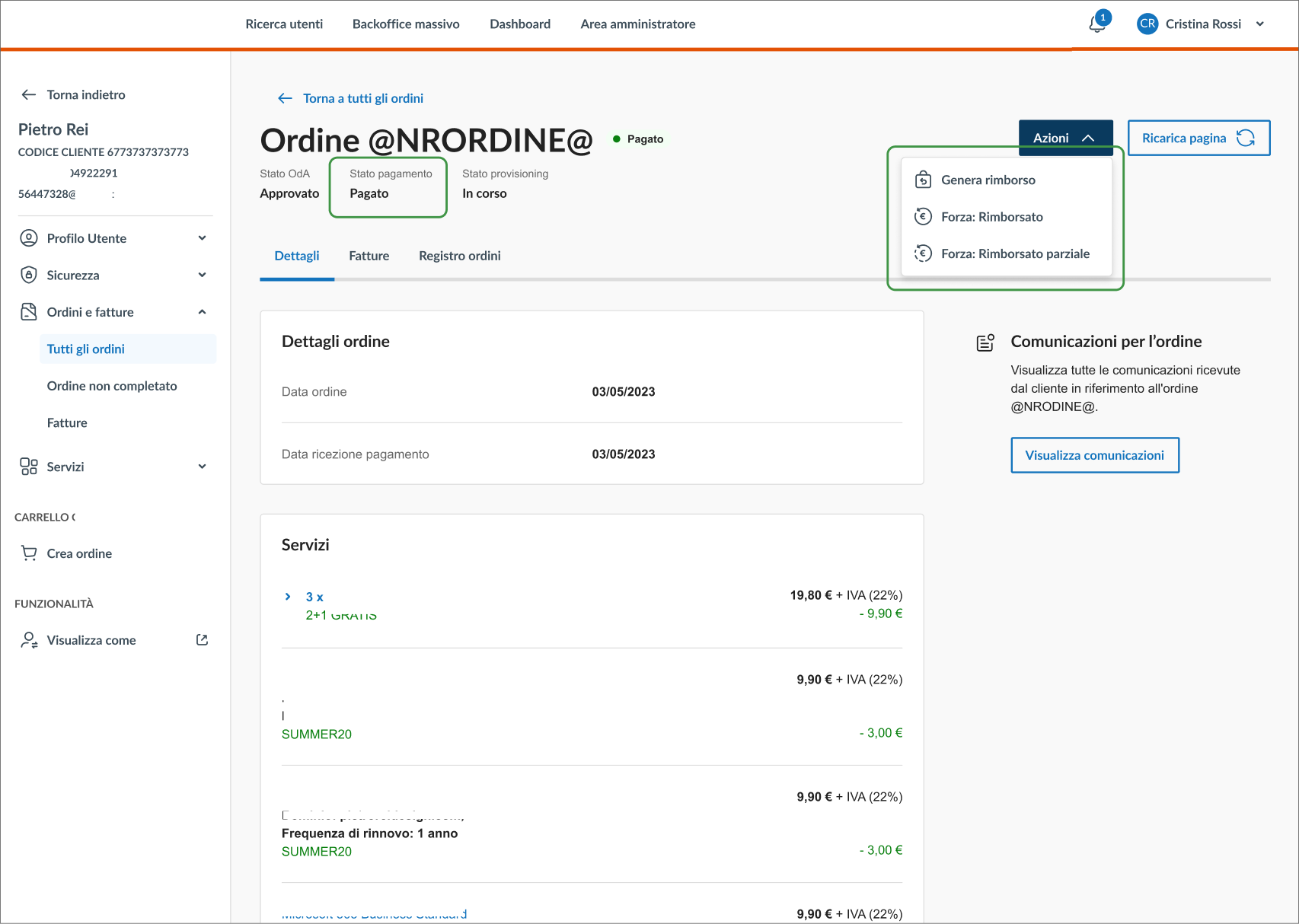
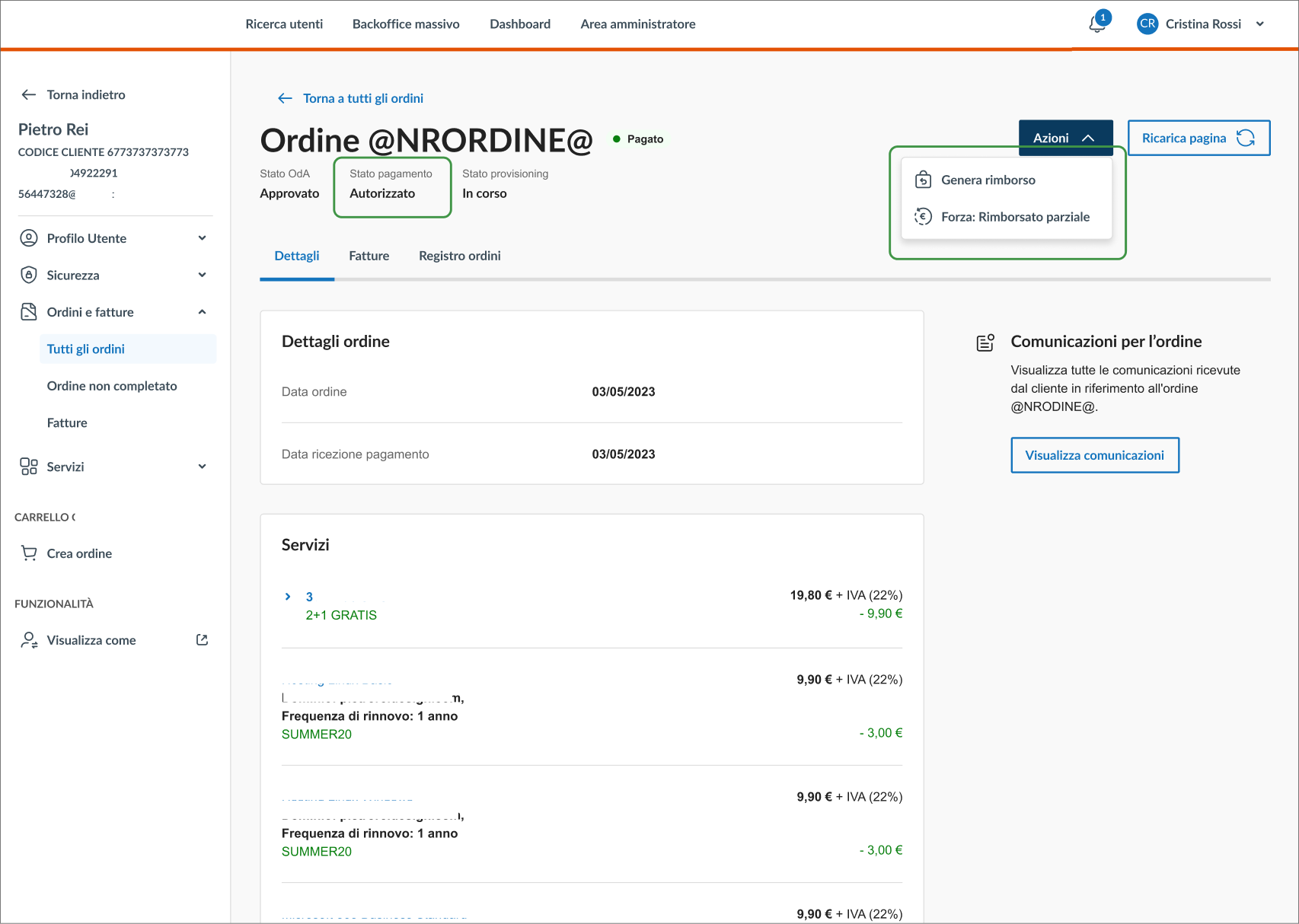
These two screens show the same parent status, but a change in one of its sub-statuses results in different available actions.
This led to an update in the page layout: originally, the header only showed the parent status — it was later updated to include the full triplet to clarify system behavior.
Order Sheet – Status Variations & Actions
PHASE 3: High-Fidelity Prototyping:
→ Overview
→ Navigation Logic
→ Table Behavior
→ Customer Sheet
→ Massive BackOffice
→ Team Alignment
Massive BackOffice & Automation
This stream had a dedicated IA, roadmap, and stakeholder group.We tackled little-known workflows (e.g. reporting, failed payments) that involved highly technical logic.
Our main challenge was to understand how operators really work.Example: managing failed payments required introducing operational statuses like “in progress”, “claimed”, and “released”
to avoid overlap between colleagues.
🎯
Goal:
Design flows with high automation and clear operational visibility.
💬
Insight
Critical insights came not from documents, but from operators’ real-life stories.
Operational Status Flow — Avoiding Work Overlaps Between Colleagues
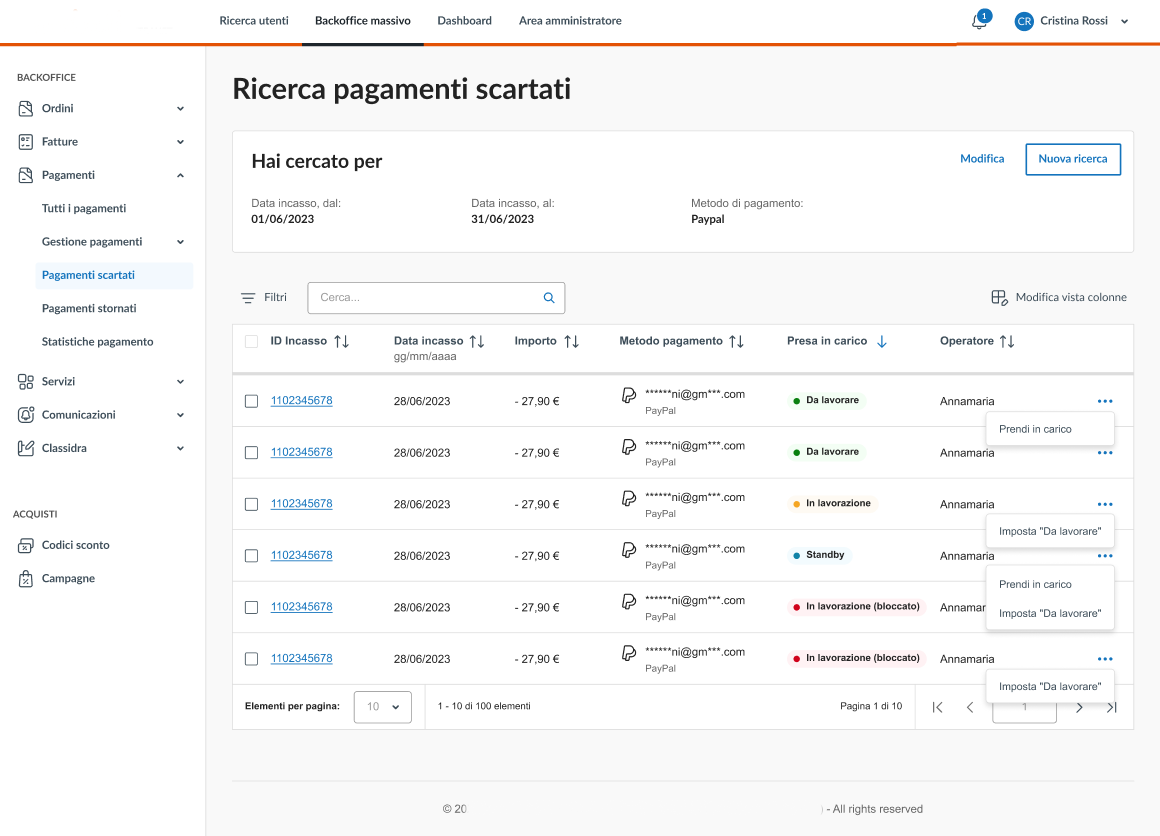
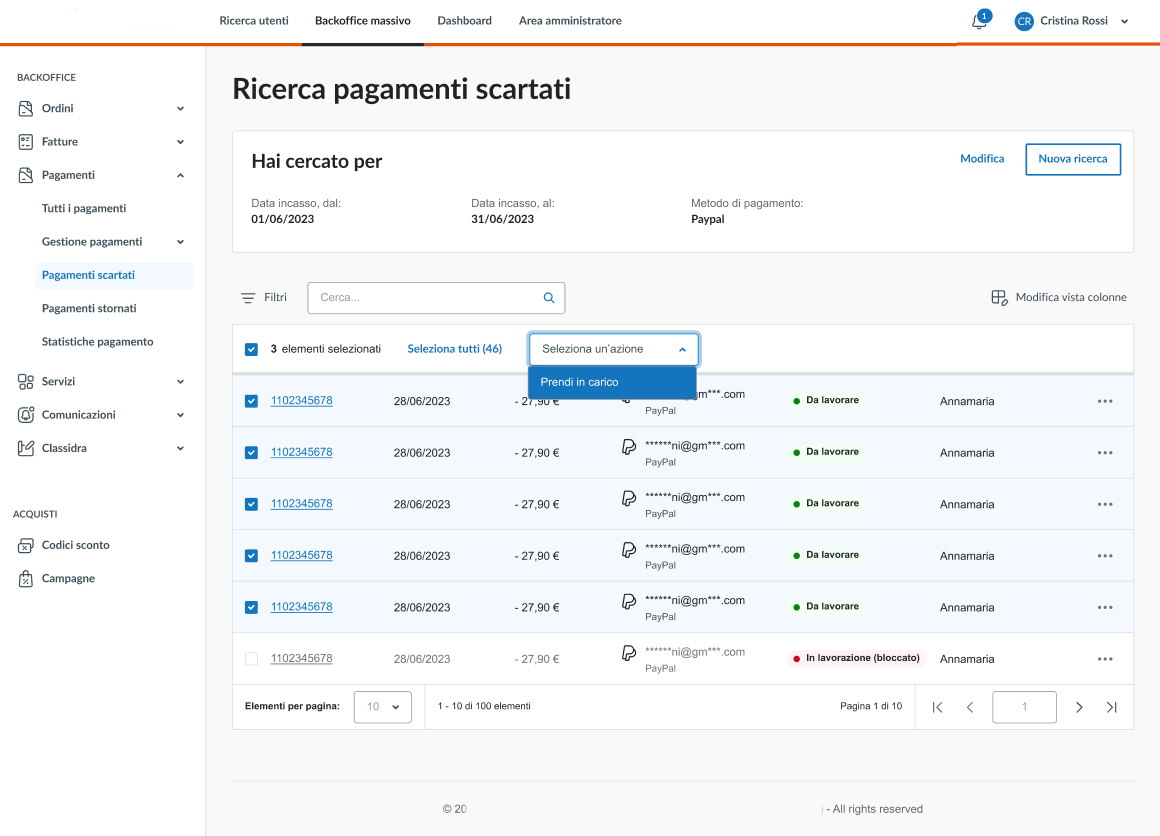
By clicking the checkboxes of multiple table rows, the operator can perform bulk actions, such as claiming multiple payments at once.
This step marks those payments as "in progress", preventing other operators from accessing them simultaneously.
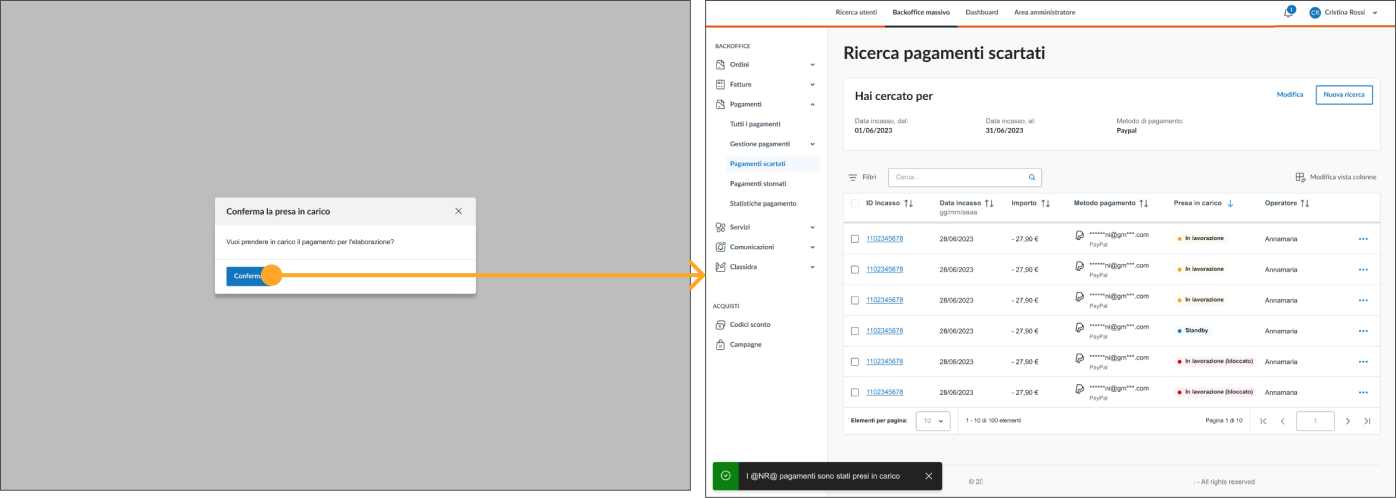
Accessing an Unclaimed Payment

The only visible action is “Claim”.
Only after this step, operators can perform further actions, ensuring clarity and avoiding task duplication.
Accessing a CLAIMED Payment

The interface shows all available operational actions. Operators can proceed with the necessary work.
PHASE 3: High-Fidelity Prototyping:
→ Overview
→ Navigation Logic
→ Table Behavior
→ Customer Sheet
→ Massive BackOffice
→ Team Alignment
Continuous Validation & Team Alignment
Each section went through multi-step validation:
→ With Analysts and POs for business logic
→ With Operators for real-world usability
→ With the Marketing team for naming and microcopy consistency
We also documented every design decision to reduce ambiguity and create a single source of truth.
🎯
Goal:
Avoid infinite feedback loops and ensure UX coherence.
💬
Insight
Design became a tool for internal alignment, not just a visual output.
Representative cases, broader impact:
This project went through many phases and iterations.In this case study, I’ve focused on the most representative examples—those that pushed the design forward and show the value of our collaboration across teams.
PHASE 4: Dev Delivery & Handoff:
→ Progressive Design Handoff by Stream
→ Support During Development & QA
Progressive Design Handoff by Stream
Each section was delivered progressively, following the priority order defined in the roadmap. Every delivery included a structured handoff and dedicated alignment sessions with the development teams.
PHASE 4: Dev Delivery & Handoff:
→ Progressive Design Handoff by Stream
→ Support During Development & QA
Support During Development & QA
Throughout the implementation phase, we supported the dev teams by addressing functional questions, providing additional documentation when needed, and assisting QA in identifying mismatches between prototypes and test environments.
[The project is currently in an advanced development stage, with several sections already released in the test environment and others in progressive rollout].
Team Leadership & Project Coordination
From designer to strategic lead in a fully-remote, multi-stream environment.
UX LEADERSHIP & TEAM OPERATIONS
Role evolution
→
Started as Senior UX Designer
→
Took over as UX Team Lead mid-project
→
Managed 3 UX Designers and owned delivery across UX streams
Team management
→
Planned and assigned design tasks across workstreams
→
Recruited and onboarded a junior designer
→
Supported team members in daily work and professional growth
Cross-team coordination
→
Aligned with POs, analysts, developers, and business stakeholders
→
Maintained UX Gantt and synced with product stream roadmaps
→
Bridged gaps between UX, tech, and business
Processes & collaboration
→
Led remote collaboration via Figma, FigJam, Jira, Confluence
→
Conducted regular design reviews and design–dev QA
→
Maintained documentation and source-of-truth boards
STRATEGIC IMPACT & PRODUCT THINKING
Product thinking & ownership
→
Contributed to MVP scoping based on user priorities and tech constraints
→
Balanced task-based flows with long-term product strategy
→
Worked closely with POs to shape feature sets and release plans
Results & impact (even partial)
→
Accelerated onboarding through streamlined UX flows
→
Reduced operator time via clear, task-oriented navigation
→
Designed scalable UX patterns now reused across multiple business lines

Learnings & Takeaways
In a project of this complexity – with strong technical constraints, a difficult-to-unravel legacy, and misaligned stakeholders – I learned that clarity, structure, and empathy are just as essential as Figma.
I had to adapt, lead, resolve conflicts, simplify complexity, and at the same time preserve design quality and team rhythm.
This was the first project where I truly grew from UX Designer to Team Lead, learning to balance ownership, support, and product vision.
As UX Designer
CHALLENGE
WHAT I DID
SKILLS GAINED
Legacy platform with complex business rules
Simplified key operational flows and clarified business logic through stakeholder workshops and co-design
Product thinking, flow simplification, stakeholder alignment
B2C design system applied to a complex B2B context
Proposed and led the revision of patterns based on real internal use cases
Systems thinking, pattern redesign,decision making
Gaps in functional specs and incomplete discovery
Facilitated deep-dive and discovery workshops with Functional Analysts and stakeholders
Facilitation, critical thinking, discovery techniques
Need to persuade UX-unfamiliar stakeholders
Created visual narratives and compelling pitches to align on design decisions
UX storytelling, persuasion,communication strategy
As UX Team Lead
CHALLENGE
WHAT I DID
SKILLS GAINED
Stepped in as Lead mid-project
Restructured the UX backlog, realigned roadmap and tasks, and redefined priorities
Leadership, planning, backlogmanagement
Distributed team under pressure
Supported the team in daily delivery and growth while maintaining quality and timelines
Mentorship, conflict resolution, process leadership
Cross-alignment with Product and Tech teams
Managed the UX roadmap and facilitated syncs with POs, developers, and analysts
Agile mindset, stakeholder orchestration, product ops
Multi-stream project with progressive rollout
Contributed to MVP definition, wrote user stories, and designed incremental logic
Strategic thinking, MVP scoping, Jira ownership
Lack of insight on certain services
Participated in data reading and testing, turning findings into UX improvements
Data literacy, metric-to-action, UX prioritization
MORE PROJECTS
SaaS SOLUTIONS / FROM COMPLEXITY TO CLARITY / SEAMLESS USER JOURNEYS
Whitelable
E-commerce Ecosystem
End-to-end UX design of a custom enterprise platform — from business needs to tested product.
View Case Study

FINTECH / MOBILE APP / UX FLOWS
Push Notifications for Mobile Banking app
Enhancing UX with a clear and scalable communication system
View Case Study
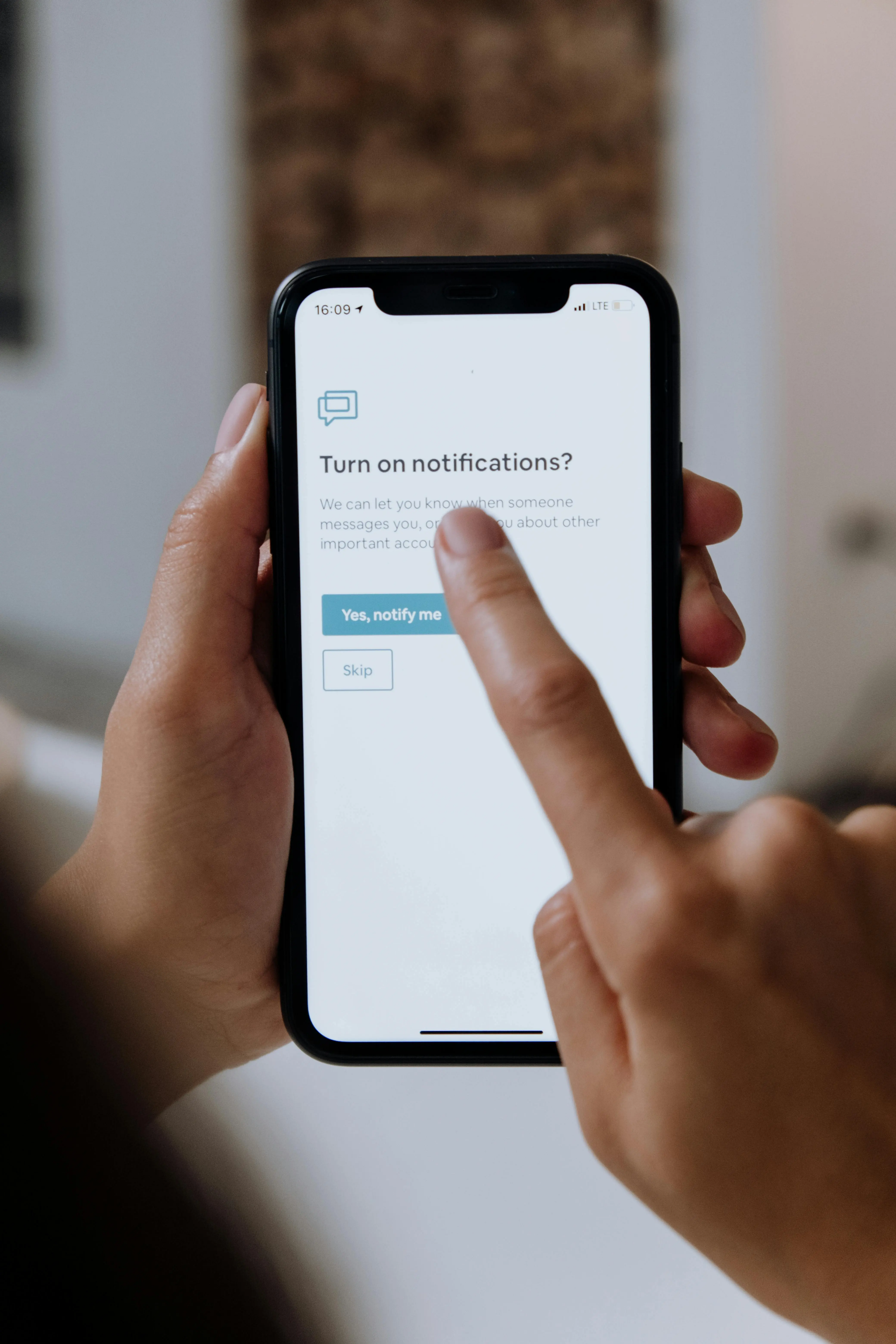
Enterprise Solutions / B2B Platform / Complex Workflows
Corporate Intranet
Platform
Transforming a legacy internal tool into a scalable, task-oriented intranet for customer service operators
OVERVIEW
Redesign of a large-scale internal platform for a leading Italian company in the cloud and digital services sector.
The intranet is used daily by internal service operators to handle key business operations across customer care, orders, services, billing, and payments.
Originally built as a legacy system, it had evolved without a clear UX strategy— growing around technical constraints instead of user needs.
We redesigned it to be more intuitive, task-focused, and aligned with real operational needs.
I joined as Senior UX Designer, later taking on the role of Team Lead, guiding the design direction and team coordination.
ABOUT THE PROJECT
Role:
Senior UX Designer → UX Design Lead
Time:
Feb 2023 - Nov 2024
(UX completed, dev in progress)
Team:
4 UX Designers, Product Owners, Business Analysts, Dev Team, Operators platform
Cient:
Name withheld due to confidentiality agreements
Key Challenges
UX DESIGN CHALLENGES
→
Heavy documentation but unclear context: Requirements were unfiltered, jargon-heavy, and hard to interpret
→
Complex processes with minimal digitalization: Many operations relied on workarounds instead of proper digital flows
→
Highly specific business logic: We had to quickly understand complex concepts like refunds, order statuses, and billing rules
→
Designing for operator efficiency, not just usability: Operator habits often clashed with UX best practices
→
Strong resistance to change: Familiar patterns were preferred, even when suboptimal
→
Many voices, mixed priorities: Input came from different stakeholders—each with different priorities and knowledge gaps
PROJECT MANAGEMENt CHALLENGES (as TL)
→
Inheritance of leadership mid-project: Took over from the previous lead, reorganizing the team and clarifying priorities
→
Project roadmap and Gantt tracking: Managed timelines and deliverables across design and dev phases
→
Internal team coordination: I assigned tasks, supported junior designers, and ensured progress while delivering my own work
→
Task assignment and stream control: I monitored multiple streams and ensured consistency across designs
→
Remote team management: The entire team worked in a fully remote setup, requiring constant alignment and clear documentation
→
Supporting team needs: Handled team needs, blockers, and performance issues as needed
The Process
Structured 4-phase approach from research to delivery, across a complex legacy system.
Research & Analysis → Information Architecture → High-Fidelity Prototyping → Dev Delivery & Handoff
PHASE 1: Research & Analysis:
Requirements & Documentation →
Alignment Workshops & MVP Definition →
Visual Mapping for Internal Alignment
Requirements & Documentation
We began by analyzing a large volume of business requirements collected over time by internal operators. The material was highly technical and often unstructured.
To make sense of it, we started organizing the documentation in Excel sheets, providing an initial section-based breakdown of the platform. This helped us clarify functionalities, identify priorities, and create a shared foundation for the next steps.

PHASE 1: Research & Analysis:
Requirements & Documentation →
Alignment Workshops & MVP Definition →
Visual Mapping for Internal Alignment
Alignment Workshops & MVP Definition
We held dedicated sessions with POs, analysts, and internal operators to review collected requirements, clarify ambiguities, resolve open questions, and validate key functionalities.
The goal was to define the scope of the Minimum Viable Product (MVP) — identifying what was truly essential for go-live, what could be postponed to future iterations, and what was no longer needed.
These confirmations also allowed us to build a clear, shared structure of the platform, laying the groundwork for the next design phases.

PHASE 1: Research & Analysis:
Requirements & Documentation →
Alignment Workshops & MVP Definition →
Visual Mapping for Internal Alignment
Visual Mapping for Internal Alignment
To foster shared understanding, we created visual diagrams and conceptual mappings (such as card sorting) to represent the platform’s sections, content areas, and functional hierarchies.
These materials proved essential in building a clear, organized overview of key blocks and processes, enabling us to structure the initial versions of the Information Architecture more effectively and in alignment with the team.

PHASE 1 SUMMARY
→
Mapped 100+ functional requirements from internal documentation
→
Facilitated alignment across multiple stakeholders (POs, analysts, operators)
→
Defined the MVP scope through workshops and interviews
→
Built early visual maps to structure platform sections and functionalities
PHASE 2: Information Architecture:
Information Architecture by Stream →
Stakeholder Validation
Information Architecture by Stream
After completing the visual mapping, we had a clear and organized view of the platform’s functional areas. From this structure, we designed two distinct Information Architectures:
→ Intranet – focused on customer management
→ Massive BackOffice – dedicated to large-scale operations (orders, payments, invoices, and services)
For each stream, we defined sections, sub-sections, features, and navigation models, maintaining a careful balance between a task-based structure — aligned with the operators’ daily workflows — and a more business-oriented view, tied to product lines, team responsibilities, rollout phases, and compliance needs.
Admin settings
Dashboard
Customer Search
BackOffice (Massive)
INTRANET
Customer Sheet
Order Management, Billing & Payments
Service Configuration

Order Management
Billing & Payments
Service Configuration
Shopping Cart
Massive BackOffice
Failed Payments [operational statuses]

PHASE 2: Information Architecture:
Information Architecture by Stream →
Stakeholder Validation
Stakeholder Validation
Presentation and validation of the Information Architectures with various groups: PO, operators, analysts, and billing team. Several iterations were required due to frictions between existing operational flows and the proposed simplifications.
📆
Planning & Release Roadmap:
Once the Information Architectures were validated by key stakeholders (PO, operators, analysts, and the billing team), we moved on to the next phase with a detailed roadmap.
The platform sections were broken down into project milestones, each assigned a specific level of effort, priority, and dependencies.
This planning phase was led directly by me in the role of Team Lead, and resulted in the definition of the Gantt chart, workstreams, and delivery schedule for the entire design phase.
(Project coordination will be further detailed in the dedicated project management section).

PHASE 2 SUMMARY
→
Designed two distinct structures: Intranet (Customer Management) and Massive BackOffice (Bulk Operations)
→
Defined a scalable navigation model tailored to user roles and usage frequency
→
Prioritized content and features based on task criticality and business priorities
→
Validated the Information Architecture with cross-functional stakeholders
→
Structured the project roadmap and Gantt chart to guide design milestones
PHASE 3: High-Fidelity Prototyping:
Overview →
Navigation Logic →
Table Behavior →
Customer Sheet →
Massive BackOffice →
Team Alignment
Overview: Method, Constraints & Approach
All user flows were designed directly in high-fidelity using Figma, leveraging the client’s existing design system. Through continuous collaboration with stakeholders, analysts, and service operators, we adapted this B2C-oriented design system to the operational needs of a complex internal back-end tool.
We addressed legacy constraints, redefined interaction rules, and validated complex flows in areas such as billing, payments, and financial reporting—domains initially unfamiliar to the team.
🎯
Goal:
Design an operational, task-based platform by translating complex logic into clear, dense —but navigable— flows.

PHASE 3: High-Fidelity Prototyping:
Overview →
Navigation Logic →
Table Behavior →
Customer Sheet →
Massive BackOffice →
Team Alignment
Entry Point & Navigation Logic
We started by designing the navigation system: from the main menu to the landing page.
The first challenge was deciding whether the entry point should be a Dashboard or a Customer Search.
Operators clarified that every phone call starts with identifying a customer → therefore, the true homepage needed to be the search module.
🎯
Goal:
Ensure immediate access to daily operations.
💬
Insight
The IA was solid, but visual support was needed to make it understandable to non-UX stakeholders.
CUSTOMER SHEET
All relevant customer data in one place—orders, services, actions.
This screen is the operational hub where tasks are performed.

HOMEPAGE AS-IS: Dashboard
The original homepage of the tool, displaying service updates and widgets.While informative, it didn’t support operators' actual workflows, as every action starts with a customer search.

HOMEPAGE TO-BE: CUSTOMER SEARCH
After submitting a search, the input panel collapses to make room for results.
Operators can refine or restart their search with clear, dedicated buttons.
The redesigned entry point.Operators land here and immediately input customer data to begin a task.Simple, focused, and operational.


PHASE 3: High-Fidelity Prototyping:
Overview →
Navigation Logic →
Table Behavior →
Customer Sheet →
Massive BackOffice →
Team Alignment
Table Behavior & Action Logic
Tables were a major usability issue: overloaded, horizontally scrollable, and with actions hidden in the far-right column—per B2C DS rules.
From user testing, it was clear that actions needed to be immediate and visible.
We restructured the tables so that:
→ The first column became the main access point
→ Actionable columns became fully clickable, speeding up task execution
🎯
Goal:
Adapt the design system to real, daily operational needs.
💬
Insight
Fewer clicks → faster tasks → large-scale efficiency.
All possible actions were grouped in the last column.
Operators first had to identify the right row, then select an action— often requiring extra steps even for frequent tasks like opening order or payment details.
Actions in the right column (AS-IS)

The Order and Payment columns became fully clickable, allowing direct access to related details. Action buttons were reduced to those strictly needed for operational tasks.
Clickable columns for faster access (TO-BE)

PHASE 3: High-Fidelity Prototyping:
Overview →
Navigation Logic →
Table Behavior →
Customer Sheet →
Massive BackOffice →
Team Alignment
Customer Sheet & Order Logic
The customer profile included highly complex flows: orders, active services, statuses, and conditional actions.The biggest blocker was the order status, initially described as simple, but actually composed of three interdependent layers, each affecting system behavior.
To resolve this, we co-created a Status → Actions matrix with stakeholders across Finance, POs, Service, and Billing to ensure alignment.
🎯
Goal:
Clarify what users can (or cannot) do depending on order status.
💬
Insight
Without a shared understanding of order status, UX flows were fragile and unreliable.
[Zoom highlights one specific status with its triplet of sub-statuses]
Status → Actions Matrix
The complete view of the matrix shows how each parent status is influenced by a combination of three sub-statuses.
Approvato
AZIONI NUOVO RILASCIO
Approvato
Approved
Approved
Pagato
Pagato
Attivo
Non attivo
Paid
Paid
Fulfilled
Unfulfilled
PAGATO
PAGATO
PAGATO
PAGATO
STATO ODA eCom
Cancellato
STATO INTRANET
STATO ACU
STATO PROVISIONING
Cancellato
Cancellato
Cancellato
STATO PAGAMENTO
Nuovo
Approvato
Bozza
Cancellato
Cancellato
Approvato
Approvato
Approvato
Approvato
Approvato
Approvato
Approvato
Approvato
Approvato
Nuovo
Approvato
Approvato
Approvato
Approvato
Cancelled
Approvato
Nuovo
Nuovo
New
Pagato
Cancelled
Cancelled
Non attivo
Approvato
Cancelled
Paid
Nuovo
Approved
Approved
Approved
Draft
Cancelled
Cancelled
Approved
Approved
Rimborsato
Approved
Nuovo
Unfulfilled
Approved
Approved
Autorizzato
Approved
Bozza
Attivo
Fallitto
Approved
Approved
Approved
New
Rimborsato
New
Non attivo
Approved
Non attivo
PAGATO
Refunded
Autorizzato
Bozza
Eliminato
Non attivo
Rimborsato
In corso
New
Non attivo
Draft
Failed
Non attivo
Non attivo
In corso
PAGATO
Refunded
Parzialmente rimborsato
Fulfilled
Parzialmente rimborsato
Omaggio
Autorizzato
Approved
Approved
Authorized
Authorized
Draft
Cleared
Refunded
Unfulfilled
Unfulfilled
In corso
Attivo
In corso
Draft
Unfulfilled
Attivo
Non attivo
Attivo
In Progress
Postponed
Postponed
Postponed
RIMBORSATO
Unfulfilled
Unfulfilled
Unfulfilled
in progress
Partially refunded
Partially refunded
Omaggio
Parzialmente rimborsato
In Progress
Authorized
RIMBORSATO
ANNULLATO
Approved
ANNULLATO
Partially Paid
Draft
Draft
Postponed
Draft
RIMBORSATO
Fulfilled
In Progress
Bozza
[Non esiste]
[Non esiste]
In progress
Fulfilled
In Progress
RIMBORSATO
Unfulfilled
PAGATO
BOZZA
non ci sarà dettaglio
ANNULLATO
RIMBORSATO
ATTESA PAGAMENTO
Non attivo
In corso
Posticipato
New
PAGATO
[Non esiste]
[Non esiste]
RIMBORSATO
Posticipato
In Progress
Unfulfilled
Posticipato
Fulfilled
ATTESA PAGAMENTO
Unfulfilled
Unfulfilled
ATTESA PAGAMENTO
PAGATO
ATTESA PAGAMENTO
OMAGGIO
In corso
Attivo
Non attivo
Fulfilled
PAGATO
Parzialmente pagato
Bozza
Bozza
Posticipato
Bozza
Partially refunded
PAGATO
ATTESA PAGAMENTO
ATTESA PAGAMENTO
ATTESA PAGAMENTO
ATTESA PAGAMENTO
ATTESA PAGAMENTO
In corso
Non attivo
Attivo
Non attivo
Non attivo
New
Unfulfilled
Partially Paid
Partially Paid
PAGATO
Pagato
Unfulfilled
Fulfilled
PAGATO
PAGATO
PAGATO
ATTESA PAGAMENTO
ATTESA PAGAMENTO
Parzialmente pagato
Parzialmente pagato
Parzialmente pagato
Autorizzato
In corso
Non attivo
Non attivo
Paid
Partially Paid
Authorized
In Progress
Unfulfilled
Unfulfilled
PAGATO
PAGATO
PAGATO
ATTESA PAGAMENTO
PAGATO
ATTESA PAGAMENTO
APPROVATO
ATTESA PAGAMENTO
ATTESA PAGAMENTO
ATTESA PAGAMENTO
POSTICIPATO
POSTICIPATO
POSTICIPATO
ATTESA PAGAMENTO
ATTESA PAGAMENTO
ATTESA PAGAMENTO
ATTESA PAGAMENTO
ATTESA PAGAMENTO
Approved
Cleared
Unfulfilled
Approvato
Approved
Cleared
STORNATO
Eliminato
STORNATO
STORNATO
STORNATO
Approvato
Approvato
Approved
Cleared
Eliminato
Fulfilled
Eliminato
Non attivo
STORNATO
Attivo
STORNATO
Parzialmente pagato
APPROVATO
APPROVATO
POSTICIPATO
ATTESA PAGAMENTO
ATTESA PAGAMENTO
Parzialmente pagato
Parzialmente pagato
PAGATO
PAGATO
OMAGGIO
Parzialmente rimborsato
Parzialmente rimborsato
ATTESA PAGAMENTO
Parzialmente pagato
PAGATO
Parzialmente rimborsato
Genera rimborso
Forza: RImborsato
Forza: Rimborsato parziale
Genera rimborso
Forza: RImborsato
Forza: Rimborsato parziale
Imposta pagato
Genera Rimborso
Forza: Rimborsato
Forza: rimborsato parziale
Approva e attiva
Imposta pagato
Forza: Rimborsato
Forza: rimborsato parziale
Imposta pagato
Genera rimborso
Forza: Rimborsato
Forza: rimborsato parziale
Imposta pagato
Genera rimborso
Forza: Rimborsato
Forza: rimborsato parziale
Genera Rimborso
Forza: Rimborsato
Forza: Rimborsato parziale
Forza: Rimborsato
Forza: Rimborsato parziale
Genera Rimborso
Forza: Rimborsato
Forza: Rimborsato parziale
Imposta Pagato
Forza: Rimborsato
Forza: Rimborsato parziale
Imposta Pagato
Forza: Rimborsato
Forza: Rimborsato parziale
Forza: Rimborsato
Forza: Rimborsato parziale
Imposta Pagato
Forza: Rimborsato
Forza: Rimborsato parziale
Imposta Pagato
Forza: Rimborsato
Forza: Rimborsato parziale
AZIONI
Genera rimborso
Forza: RImborsato
Forza: Rimborsato parziale
NESSUNA AZIONE
NESSUNA AZIONE
NESSUNA AZIONE
NESSUNA AZIONE
NESSUNA AZIONE
NESSUNA AZIONE
IMPOSTA PAGATO
IMPOSTA PAGATO
IMPOSTA PAGATO
IMPOSTA PAGATO
NESSUNA AZIONE
NESSUNA AZIONE
NESSUNA AZIONE
NESSUNA AZIONE
NESSUNA AZIONE
NESSUNA AZIONE
NESSUNA AZIONE
IMPOSTA PAGATO
NESSUNA AZIONE
NESSUNA AZIONE
NESSUNA AZIONE
IMPOSTA PAGATO
IMPOSTA PAGATO
IMPOSTA PAGATO
IMPOSTA PAGATO
IMPOSTA PAGATO
IMPOSTA PAGATO
IMPOSTA PAGATO
NESSUNA AZIONE
NESSUNA AZIONE
RIPRISTINA ORDINE
NESSUNA AZIONE
NESSUNA AZIONE
NESSUNA AZIONE
NESSUNA AZIONE
APPROVA E ATTIVA
ANNULLA ORDINE
IMPOSTA PAGATO
IMPOSTA CONDIZIONE
DI PAGAMENTO
APPROVA E ATTIVA
NESSUNA AZIONE
IMPOSTA PAGATO
IMPOSTA PAGATO
IMPOSTA PAGATO
IMPOSTA PAGATO
IMPOSTA PAGATO
IMPOSTA PAGATO
NESSUNA AZIONE
NESSUNA AZIONE
RIPRISTINA ORDINE
NESSUNA AZIONE
Approva e attiva
Annulla ordine
Imposta pagato
Imposta condizionedi pagamento
RIPRISTINA ORDINE
IMPOSTA PAGATO
APPROVA E ATTIVA
In corso
In Progress
RIPRISTINA ORDINE
FORZA: RIMBORSATO
RIPRISTINA ORDINE
FORZA: RIMBORSATO
RIPRISTINA ORDINE
FORZA : RIMBORSATO
Nuovo
New
Failed
Unfulfilled
Fallito
ATTESA PAGAMENTO
Non attivo
ATTESA PAGAMENTO
Approva e attiva
Annulla ordine
Imposta pagato
Imposta condizionedi pagamento
Approvato
Fallito
In corso
ATTESA PAGAMENTO
ATTESA PAGAMENTO
IMPOSTA PAGATO
APPROVATO
Approved
Failed
In Progress
Approvato
Fallito
Non attivo
ATTESA PAGAMENTO
ATTESA PAGAMENTO
IMPOSTA PAGATO
APPROVATO
Approved
Failed
Unfulfilled
Approvato
Fallito
Attivo
ATTESA PAGAMENTO
ATTESA PAGAMENTO
IMPOSTA PAGATO
APPROVATO
Approved
Failed
Fulfilled
IMPOSTA PAGATO
IMPOSTA PAGATO
IMPOSTA PAGATO
IMPOSTA PAGATO
IMPOSTA PAGATO
IMPOSTA PAGATO
IMPOSTA PAGATO
Approvato
AZIONI
NUOVO RILASCIO
Approvato
Approved
Approved
Pagato
Pagato
Attivo
Non attivo
Paid
Paid
Fulfilled
Unfulfilled
PAGATO
PAGATO
PAGATO
PAGATO
STATO ODA
eCom
STATO INTRANET
STATO ACU
STATO
PROVISIONING
STATO
PAGAMENTO
Nuovo
Approvato
Approvato
Approvato
Approvato
Approvato
Nuovo
New
Pagato
Non attivo
Approvato
Paid
Approved
Approved
Nuovo
Unfulfilled
Approved
Autorizzato
Approved
Approved
PAGATO
Autorizzato
In corso
New
Non attivo
PAGATO
Parzialmente
rimborsato
Parzialmente
rimborsato
Autorizzato
Authorized
Authorized
In corso
Attivo
Attivo
In Progress
Unfulfilled
Partially refunded
Partially refunded
Parzialmente
rimborsato
Authorized
Approved
Fulfilled
In Progress
PAGATO
Non attivo
PAGATO
PAGATO
Fulfilled
PAGATO
Partially refunded
PAGATO
New
Unfulfilled
PAGATO
Pagato
PAGATO
PAGATO
PAGATO
Autorizzato
In corso
Non attivo
Paid
Authorized
In Progress
Unfulfilled
PAGATO
PAGATO
PAGATO
PAGATO
PAGATO
Parzialmente rimborsato
PAGATO
Parzialmente rimborsato
PAGATO
Parzialmente rimborsato
Genera rimborso
Forza: RImborsato
Forza: Rimborsato parziale
Genera rimborso
Forza: RImborsato
Forza: Rimborsato parziale
Genera Rimborso
Forza: Rimborsato
Forza: Rimborsato parziale
Forza: Rimborsato
Forza: Rimborsato parziale
Genera Rimborso
Forza: Rimborsato
Forza: Rimborsato parziale
Imposta Pagato
Forza: Rimborsato
Forza: Rimborsato parziale
Imposta Pagato
Forza: Rimborsato
Forza: Rimborsato parziale
Forza: Rimborsato
Forza: Rimborsato parziale
Imposta Pagato
Forza: Rimborsato
Forza: Rimborsato parziale
Imposta Pagato
Forza: Rimborsato
Forza: Rimborsato parziale
AZIONI
Genera rimborso
Forza: RImborsato
Forza: Rimborsato parziale
NESSUNA AZIONE
NESSUNA AZIONE
NESSUNA AZIONE
NESSUNA AZIONE
IMPOSTA PAGATO
IMPOSTA PAGATO
IMPOSTA PAGATO
IMPOSTA PAGATO
NESSUNA AZIONE
NESSUNA AZIONE
NESSUNA AZIONE


These two screens show the same parent status, but a change in one of its sub-statuses results in different available actions.
This led to an update in the page layout: originally, the header only showed the parent status — it was later updated to include the full triplet to clarify system behavior.
Order Sheet – Status Variations & Actions
PHASE 3: High-Fidelity Prototyping:
Overview →
Navigation Logic →
Table Behavior →
Customer Sheet →
Massive BackOffice →
Team Alignment
Massive BackOffice & Automation
This stream had a dedicated IA, roadmap, and stakeholder group.We tackled little-known workflows (e.g. reporting, failed payments) that involved highly technical logic.
Our main challenge was to understand how operators really work.Example: managing failed payments required introducing operational statuses like “in progress”, “claimed”, and “released”
to avoid overlap between colleagues.
🎯
Goal:
Design flows with high automation and clear operational visibility.
💬
Insight
Critical insights came not from documents, but from operators’ real-life stories.
Operational Status Flow — Avoiding Work Overlaps Between Colleagues


By clicking the checkboxes of multiple table rows, the operator can perform bulk actions, such as claiming multiple payments at once.
This step marks those payments as "in progress", preventing other operators from accessing them simultaneously.
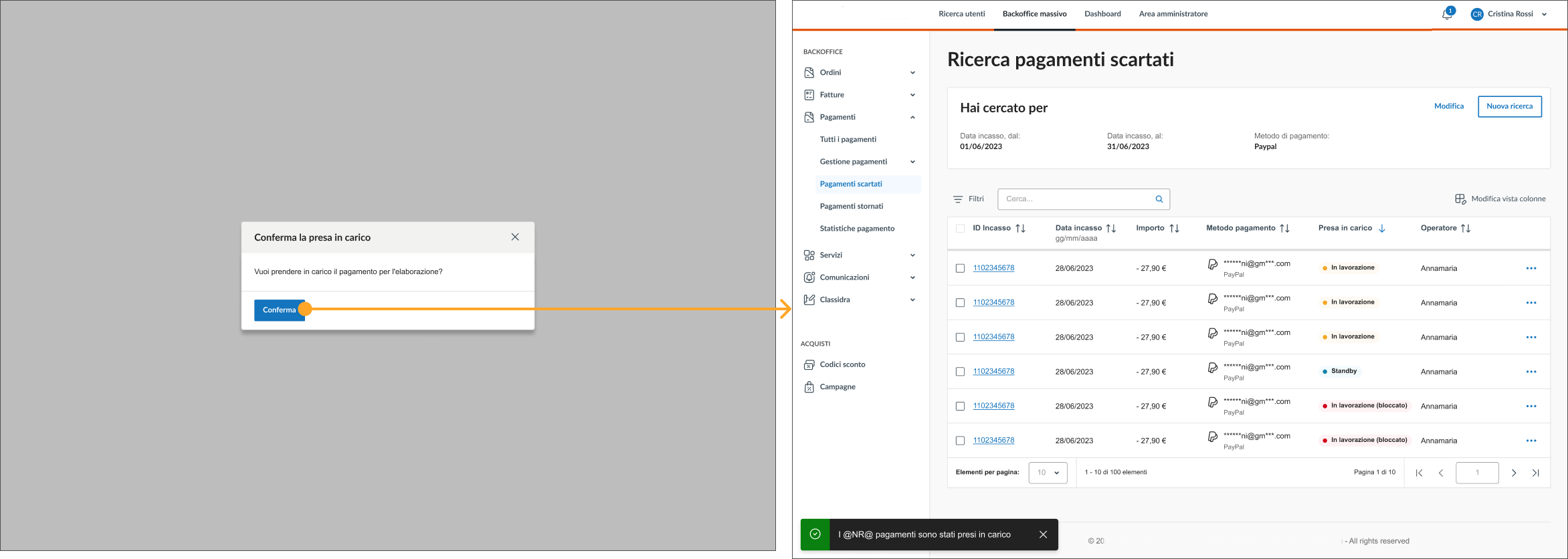
Accessing an Unclaimed Payment

The only visible action is “Claim”.
Only after this step, operators can perform further actions, ensuring clarity and avoiding task duplication.
Accessing a CLAIMED Payment

The interface shows all available operational actions. Operators can proceed with the necessary work.
PHASE 3: High-Fidelity Prototyping:
Overview →
Navigation Logic →
Table Behavior →
Customer Sheet →
Massive BackOffice →
Team Alignment
Continuous Validation & Team Alignment
Each section went through multi-step validation:
→ With Analysts and POs for business logic
→ With Operators for real-world usability
→ With the Marketing team for naming and microcopy consistency
We also documented every design decision to reduce ambiguity and create a single source of truth.
🎯
Goal:
Avoid infinite feedback loops and ensure UX coherence.
💬
Insight
Design became a tool for internal alignment, not just a visual output.
Representative cases, broader impact:
This project went through many phases and iterations.In this case study, I’ve focused on the most representative examples—those that pushed the design forward and show the value of our collaboration across teams.
PHASE 4: Dev Delivery & Handoff:
Progressive Design Handoff by Stream →
Support During Development & QA
Progressive Design Handoff by Stream
Each section was delivered progressively, following the priority order defined in the roadmap. Every delivery included a structured handoff and dedicated alignment sessions with the development teams.
PHASE 4: Dev Delivery & Handoff:
Progressive Design Handoff by Stream →
Support During Development & QA
Support During Development & QA
Throughout the implementation phase, we supported the dev teams by addressing functional questions, providing additional documentation when needed, and assisting QA in identifying mismatches between prototypes and test environments.
[The project is currently in an advanced development stage, with several sections already released in the test environment and others in progressive rollout].
Team Leadership & Project Coordination
From designer to strategic lead in a fully-remote, multi-stream environment.
UX LEADERSHIP & TEAM OPERATIONS
Role evolution
→
Started as Senior UX Designer
→
Took over as UX Team Lead mid-project
→
Managed 3 UX Designers and owned delivery across UX streams
Team management
→
Planned and assigned design tasks across workstreams
→
Recruited and onboarded a junior designer
→
Supported team members in daily work and professional growth
Cross-team coordination
→
Aligned with POs, analysts, developers, and business stakeholders
→
Maintained UX Gantt and synced with product stream roadmaps
→
Bridged gaps between UX, tech, and business
Processes & collaboration
→
Led remote collaboration via Figma, FigJam, Jira, Confluence
→
Conducted regular design reviews and design–dev QA
→
Maintained documentation and source-of-truth boards
STRATEGIC IMPACT & PRODUCT THINKING
Product thinking & ownership
→
Contributed to MVP scoping based on user priorities and tech constraints
→
Balanced task-based flows with long-term product strategy
→
Worked closely with POs to shape feature sets and release plans
Results & impact (even partial)
→
Accelerated onboarding through streamlined UX flows
→
Reduced operator time via clear, task-oriented navigation
→
Designed scalable UX patterns now reused across multiple business lines

Learnings & Takeaways
In a project of this complexity – with strong technical constraints, a difficult-to-unravel legacy, and misaligned stakeholders – I learned that clarity, structure, and empathy are just as essential as Figma.
I had to adapt, lead, resolve conflicts, simplify complexity, and at the same time preserve design quality and team rhythm.
This was the first project where I truly grew from UX Designer to Team Lead, learning to balance ownership, support, and product vision.
As UX Designer
CHALLENGE
WHAT I DID
SKILLS GAINED
Legacy platform with complex business rules
Simplified key operational flows and clarified business logic through stakeholder workshops and co-design
Product thinking, flow simplification, stakeholder alignment
B2C design system applied to a complex B2B context
Proposed and led the revision of patterns based on real internal use cases
Systems thinking, pattern redesign,decision making
Gaps in functional specs and incomplete discovery
Facilitated deep-dive and discovery workshops with Functional Analysts and stakeholders
Facilitation, critical thinking, discovery techniques
Need to persuade UX-unfamiliar stakeholders
Created visual narratives and compelling pitches to align on design decisions
UX storytelling, persuasion,communication strategy
As UX Team Lead
CHALLENGE
WHAT I DID
SKILLS GAINED
Stepped in as Lead mid-project
Restructured the UX backlog, realigned roadmap and tasks, and redefined priorities
Leadership, planning, backlogmanagement
Distributed team under pressure
Supported the team in daily delivery and growth while maintaining quality and timelines
Mentorship, conflict resolution, process leadership
Cross-alignment with Product and Tech teams
Managed the UX roadmap and facilitated syncs with POs, developers, and analysts
Agile mindset, stakeholder orchestration, product ops
Multi-stream project with progressive rollout
Contributed to MVP definition, wrote user stories, and designed incremental logic
Strategic thinking, MVP scoping, Jira ownership
Lack of insight on certain services
Participated in data reading and testing, turning findings into UX improvements
Data literacy, metric-to-action, UX prioritization
MORE PROJECTS
SaaS SOLUTIONS / FROM COMPLEXITY TO CLARITY / SEAMLESS USER JOURNEYS
Whitelabel
E-commerce Ecosystem
End-to-end UX design of a custom enterprise platform — from business needs to tested product.
View Case Study

FINTECH / MOBILE APP / UX FLOWS
Push Notifications for Mobile Banking app
Enhancing UX with a clear and scalable communication system
View Case Study

